Embark on a journey through the untamed wilderness of Poacher and witness the beautiful creatures brought to life by MPC‘s visual effects teams:
© Vincent Frei – The Art of VFX – 2024
Step into the breathtaking world of Avatar: The Last Airbender like never before and explore the various environments crafted by the teams of Pixomondo in this new VFX Breakdown:
WANT TO KNOW MORE?
Netflix: You can now watch Avatar: The Last Airbender on Netflix.
© Vincent Frei – The Art of VFX – 2024
David Simpson embarked on his journey in the realm of visual effects at Framestore back in 2008. Since then, he worked on Gravity, Fantastic Beasts and Where to Find Them, Thor: Ragnarok and His Dark Materials.
What is your background?
I studied Film Production at the Arts Institute in Bournemouth. After graduation one of my classmates secured an internship with Framestore. Luckily for me, he really impressed. I was invited to interview off the back of his hard work! I started in Paint & Roto and worked my way through the ranks.
How was this new collaboration Director Alex Garland?
Really fantastic. I think it’s turned out great and I’m so thankful to be a part of it. It was an enjoyable project – but that’s not to say it was easy. It was a lot of hard work and took a delicate hand.
Civil War always needed VFX (there are some things you just can’t film) but simultaneously those VFX needed to feel natural and grounded. The style was almost documentary – anything too Hollywood, or showy, would detract from the experience. We spent a lot of time dialling that in and finding the balance between scale and realism.
I think Alex uses VFX in a very artful way – it’s considered and restrained. He has a great eye and a pragmatic mind. When you work with Alex he wants every department to be involved in the creative process. He’ll listen to and consider any idea, wherever it comes from. It’s very collaborative.
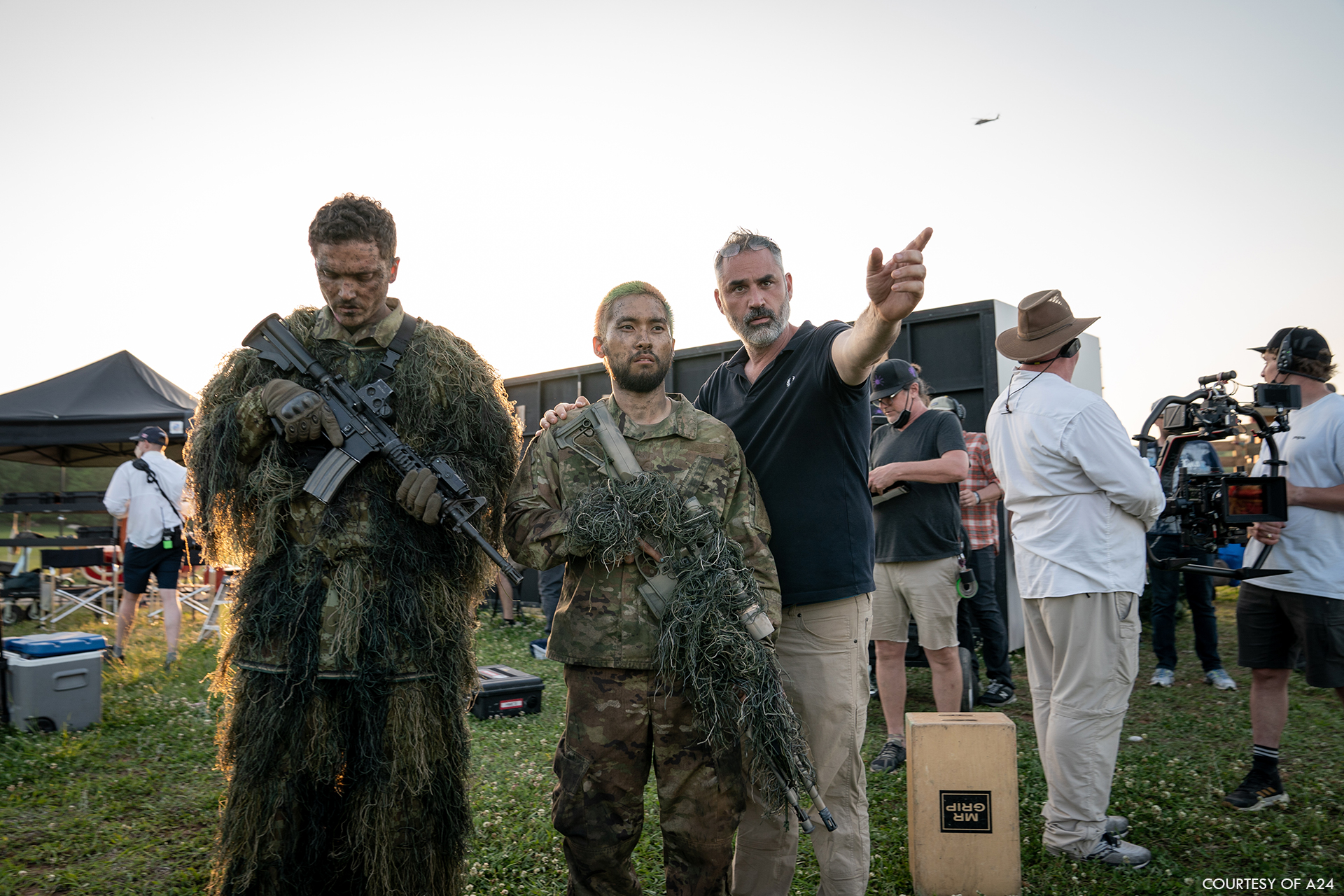
How did you organize the work with your VFX Producer?
There was a lot of VFX work across the show and with only a relatively small team. Michelle Rose and I worked to balance everything in the most efficient way possible.
Framestore took on the lion’s share of the work. Anything that would require lots of creative iteration, design, or CG went to them. This included digi doubles, FX sims, environments.
TPO were based at the edit suite and were fantastic for anything with a quick turn around or temps. They took on a lot of the more editorial or 2D tasks, plus TPO became our go-to team for shootouts. They added bullet holes and impacts all over the daytime sequence at the office building and the climax inside the White House.
Finally, FIXFX picked up a lot of the invisible cleanup work. We had the usual cleanup tasks, but also things you might not even think of. FIXFX were great at those subtle, invisible, world building moments – like removing pedestrians and vehicles, adding an eerie emptiness throughout the film. We also removed planes from the sky as we felt it would be a no fly zone.
Of course, as is the case with all films, plans change and the edit is constantly in flux. Alex is always coming up with new ideas, so we were all kept on our toes!
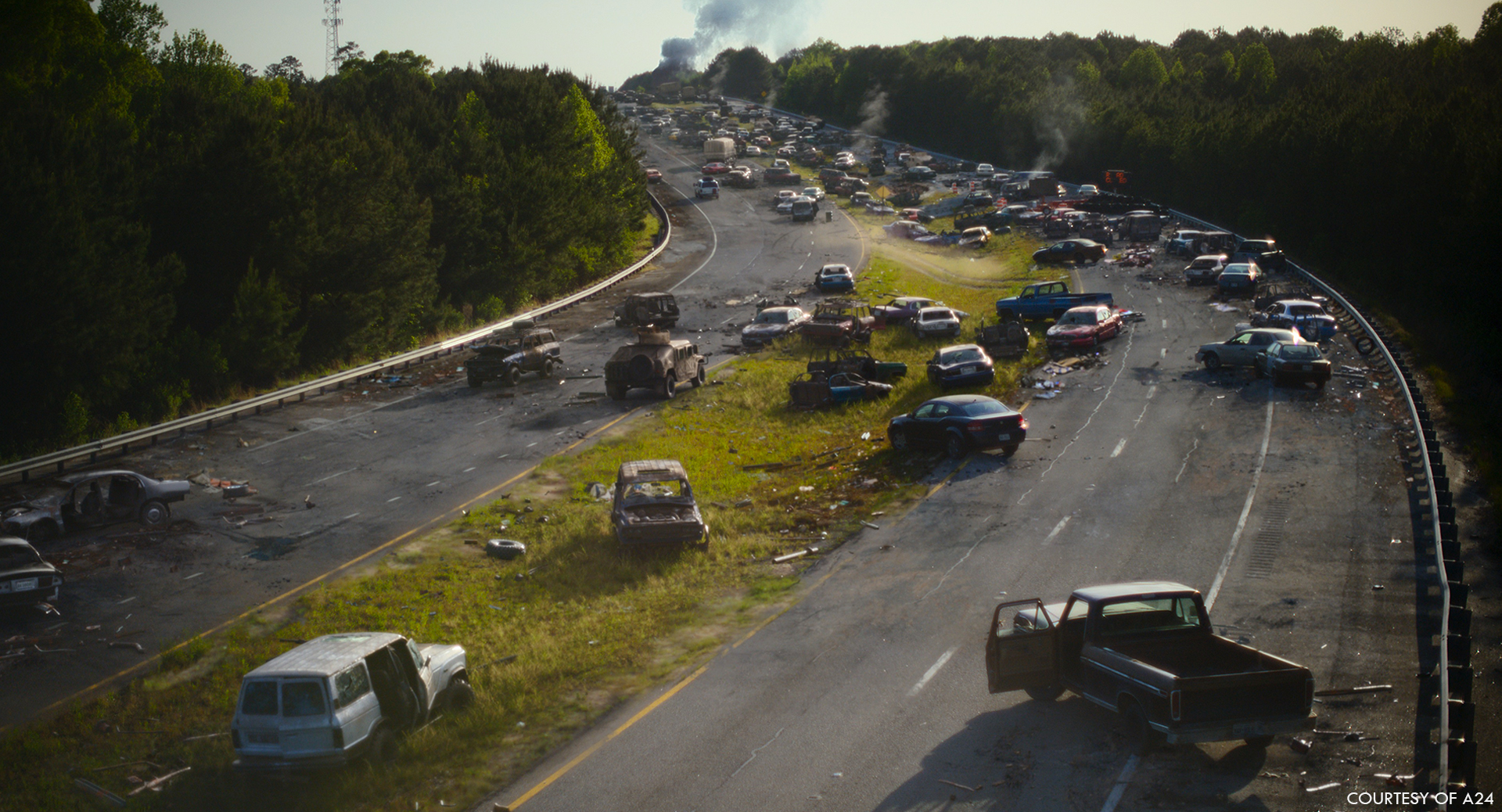
What is the your role on set and how do you work with other departments?
The shoot took place in Atlanta towards the end of the COVID protocols, which allowed us much more face to face interaction between departments. We were all based in the same production office, which really helped collaboration.
Alex and Rob (Hardy, Cinematographer) like to shoot fast. There are always multiple cameras shooting, in a very organic way. Obviously, preparation and planning are vital, but they are also cautious of tunnel vision. No one wants to get too fixated on the plans and miss something fantastic or unexpected.
Therefore VFX needed to be flexible. Throughout the shoot, we often found plans, staging, shots or methodologies changed. Some practical effects didn’t work, others worked better than expected. Michelle and I were constantly re-evaluating and re-strategising, adapting to the natural flow of the production.
On set, Michelle and I worked with VFX Supervisor Chris Zeh. Chris is a seasoned member of the Framestore team and went on to act as our Compositing Supervisor in post. Having continuity between the shoot and the studio working on the final VFX was hugely beneficial. By being on set, Chris took a lot of knowledge into post and built up a valuable early relationship with the team.
Can you elaborate on the process of integrating invisible visual effects to enhance the cinematic experience while maintaining realism?
This is a war film. We wanted to approach that subject with as much respect and authenticity as possible. The intention was never to glamourise war – in fact, from a VFX perspective, we steered away from ‘cinema’ as much as possible specifically to avoid exactly that.
Any references we used came from real world footage. We deliberately avoided looking at other films for inspiration. As a strict rule, our references came from news footage, documentaries, ammunition tests – anything real.
For each visual effect, we sourced a number of references and presented them to Alex. He chose his favourites, based on what best served the story. Those became our anchors in VFX. We called this process “casting” our effects.
From there, the team meticulously analysed and recreated the references to integrate into our shots. We would study the references and ask “what makes this so shocking?” or “how can we get our shot to feel like this?”. It was a real, frame-by-frame, under-a-microscope style process.
It was difficult – you’re looking at real events and real people, which can be very distressing – but, at the same time, we wanted to be respectful and truthful. We took that very seriously.
How did you approach the challenge of seamlessly blending CGI elements with live-action footage?
Rob always selects really beautiful lenses, with a lot of character. That really helps us in VFX. Sure, it makes compositing harder, but once you get there everything feels so more whole. It helps unify the VFX and photography.
On this show, because the photographic language was so distinctive, we really tried to recreate it in our VFX shots.
For example, on our rare full CG shots, we made sure our digital cameras matched Rob’s camera and lens package. Once we’d made our lens selection, we used the grids for the specific lens to recreate the aberration, bokeh, distortion, vignetting. We then found similar shots captured with it in Rob’s photography and took into account how he operated with that lens/camera. How was it mounted? How was it rigged? What aperture was it shot at?
All of that fed into the VFX work, to try and seamlessly hide full CG shots among plate photography. Hopefully it worked!
What specific techniques were employed to create the illusion of invisible visual effects in scenes where characters interact with CGI elements or environments?
We relied on interaction at both the beginning and end of the process.
Firstly, we always tried to have something physical on set for the actors and crew to interact with. That way, anything we add in VFX is another layer on top of reality.
Secondly, when adding something CG, we’d look for ways to have that element interact with the plate too.
For example, there’s a shot in the golf course scene where a body is run over by a car. It’s very quick, but really shocking.
On set, we had a mannequin for everyone to interact with. It gave our stunt driver something to steer towards, our cast something to react to and our cinematographer something to light and frame up on. However, the mannequin lacked weight, it moved unnaturally and always looked like we’d hit something plastic. So, in VFX we painted that mannequin out and replaced it with a digidouble.
As with all things, we first looked for references. The aim with every shot was unflinching realism, so we needed to know what “real” looked like. We found harrowing footage of accidents and studied them for weight, movement, impact.
Then, we worked with our MoCap Performers, Ace Ruele and Jordan Dumaurier, to get a first pass performance. They captured a limp body rolling which helped us with human weight and physicality. Our animation team, led by Max Solomon, then animated on top of that performance.
The challenge then became integrating that CG element into the shot – which is the second type of interaction.
For example, we adjusted the movement of the plate car (tracking, animating and reprojected) to interact with the heavier human body. For example: it bumps higher, the suspension responds differently. We also added dust and dirt to the road, for more interaction.
It’s a very quick shot, but gets a strong reaction. I think that’s the surprise and also because it feels uncomfortably realistic.
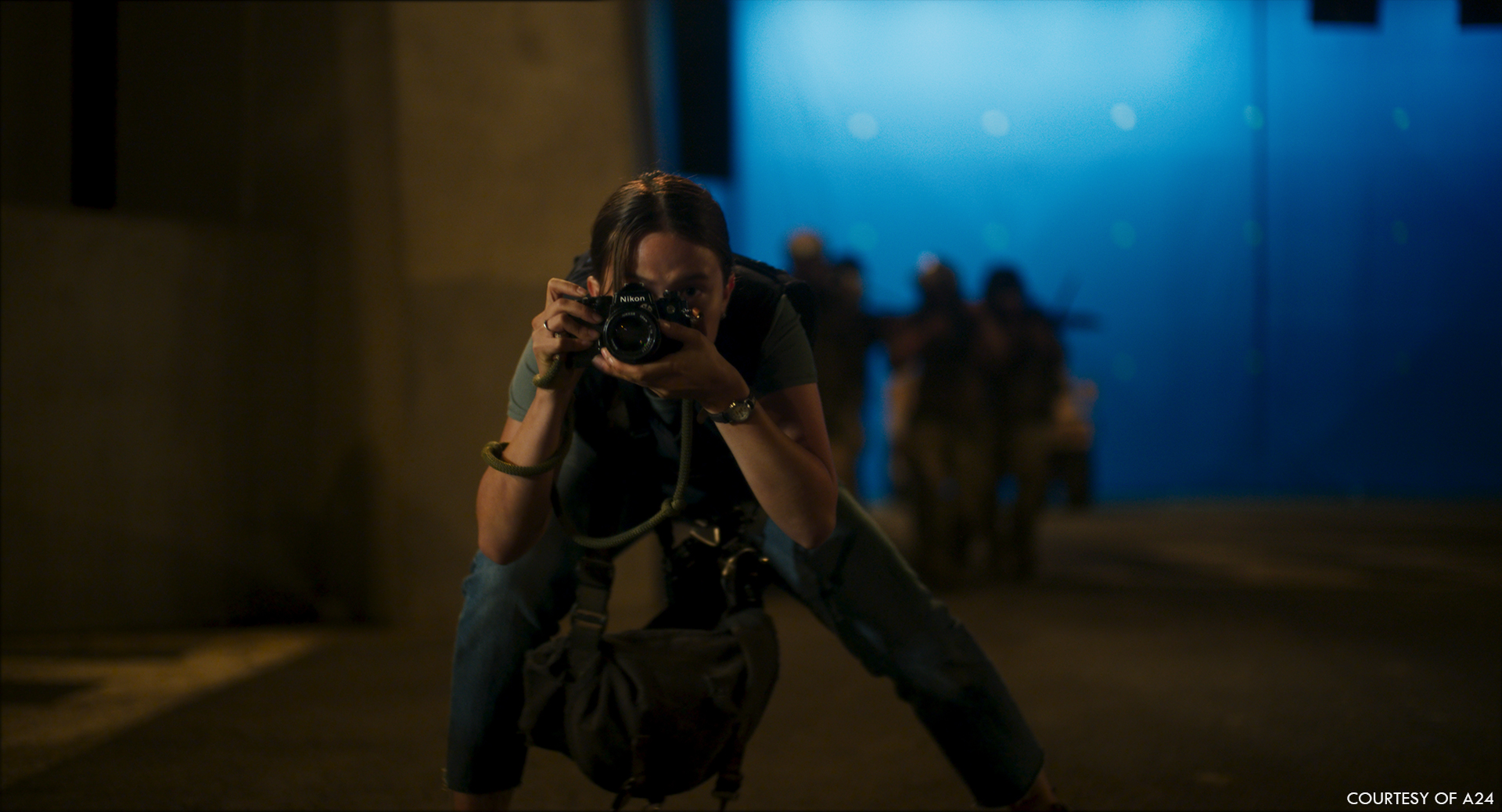
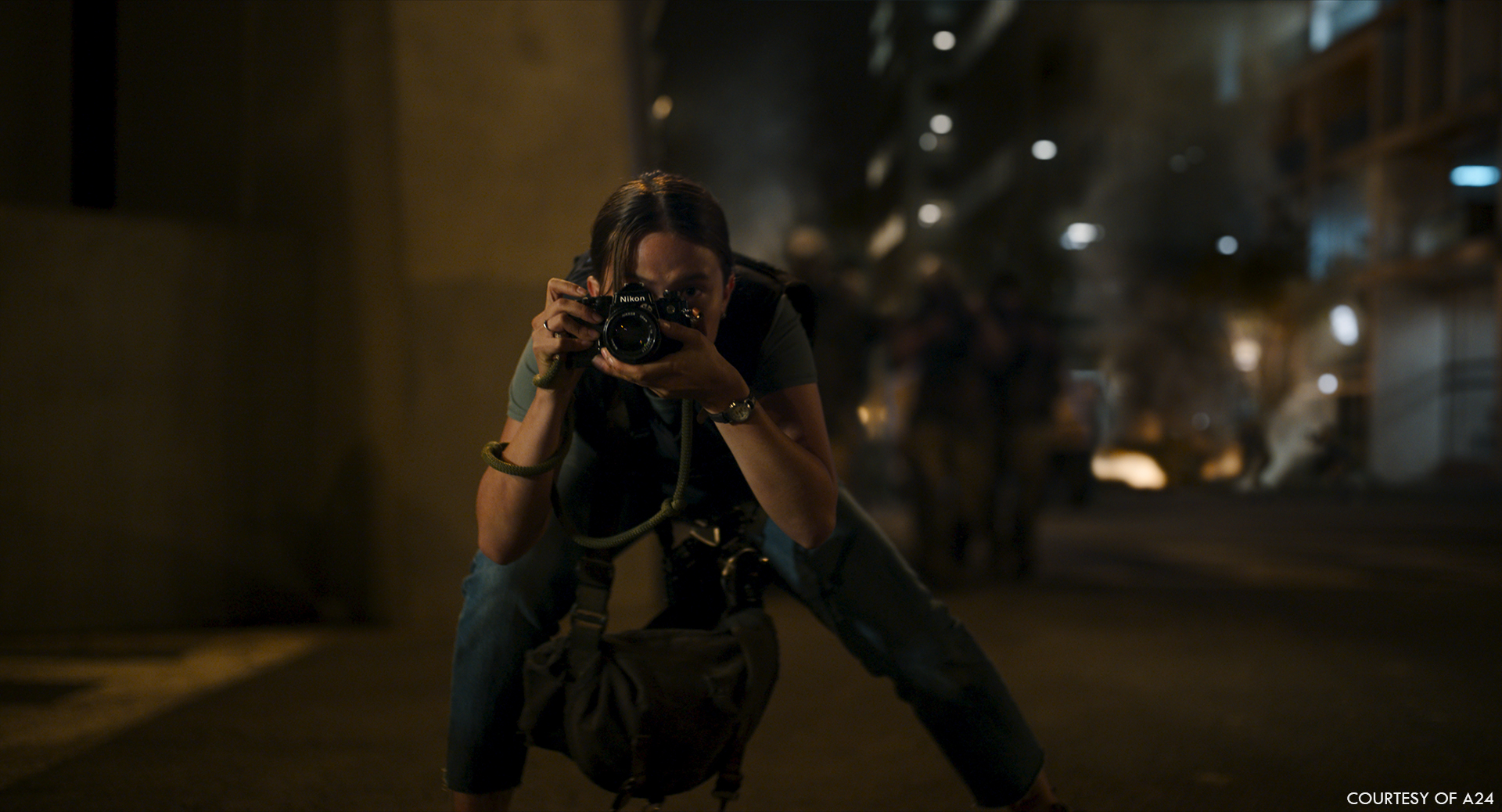
Were there any particularly challenging sequences where the use of invisible visual effects played a crucial role, and if so, how were they overcome?
I think most shows have invisible VFX. Every project nowadays has hundreds of shots that you’d never even think of – cleanup work, wig fixes, getting rid of crew, covering billboards, that sort of work. If you asked an audience member to go through a film and point out every VFX shot, I reckon more than half would go undetected.
The hardest “invisible” VFX are the visible ones. It’s easy to make something invisible when it’s out of focus in the deep background and no one’s looking at it. The real challenge is putting something in the middle of frame, pointing the audience’s attention straight at it, encouraging them to look right at it but not letting it take them out of the story.
That was the hardest part of this project for sure. We had a lot of war torn imagery and desolation. Obviously, you want the audience to see that stuff. They need to register it, but not be distracted by it. That’s a fine line to walk – large enough to have an emotional effect, but not so large as to feel fake. It took a lot of restraint and taste. Alex was really great at threading that needle.
How did you approach the task of recreating iconic landmarks of New York and Washington while the shooting took place in Atlanta?
A few months before shooting, we flew to Washington DC. We went out one night and walked from the Lincoln Memorial to the White House – taking lots of photographs and discussing sequences, staging, troop movements.
From there, we travelled back to Atlanta and locations began scouting for places that could play as DC. Atlanta has a lot of incredible locations, don’t get me wrong, but we couldn’t find anything that worked for Washington DC.
We came close with one option, but it was in the heart of the city – we were shooting in the middle of the night, with gun fire, shouting, explosions, traffic closed off, tanks tearing up tarmac. Logistically, it would have been a nightmare. In order to get permission to shoot there would have required lots of creative compromises.
Instead, we pivoted our approach towards VFX and moved to a parking lot at Stone Mountain.We had three partial builds in the Yellow Daisy Parking lot: The Lincoln Memorial, 17th Street and Pennsylvania Avenue.
17th Street and Pennsylvania Avenue were single intersections, with road markings, pavements, streetlights and the ground floor of each building. The Lincoln Memorial was a short stretch of pavement alongside a patch of grass and trees.
We positioned bluescreen in the key areas (above and into the distance), to extend the set beyond.
Michelle Rose and our lead Wrangler Corey Burks then flew to DC again to capture texture photography and scan as much as possible – passing that data over to Framestore’s environments team, who built the City.
Framestore’s environments team, lead by CG Supervisor Freddy Salazar, then set about painstakingly recreating Washington DC to an extraordinary level.
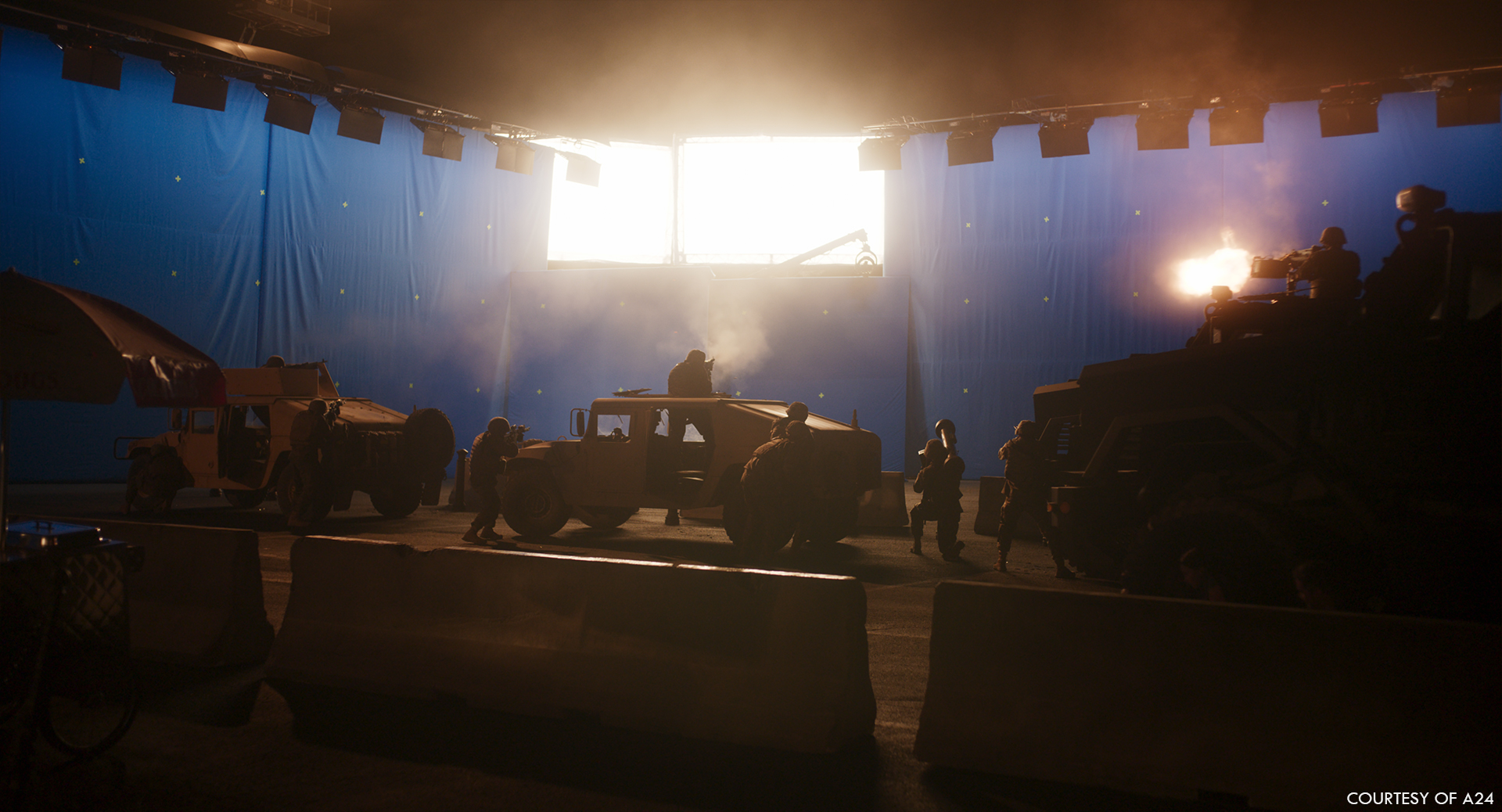
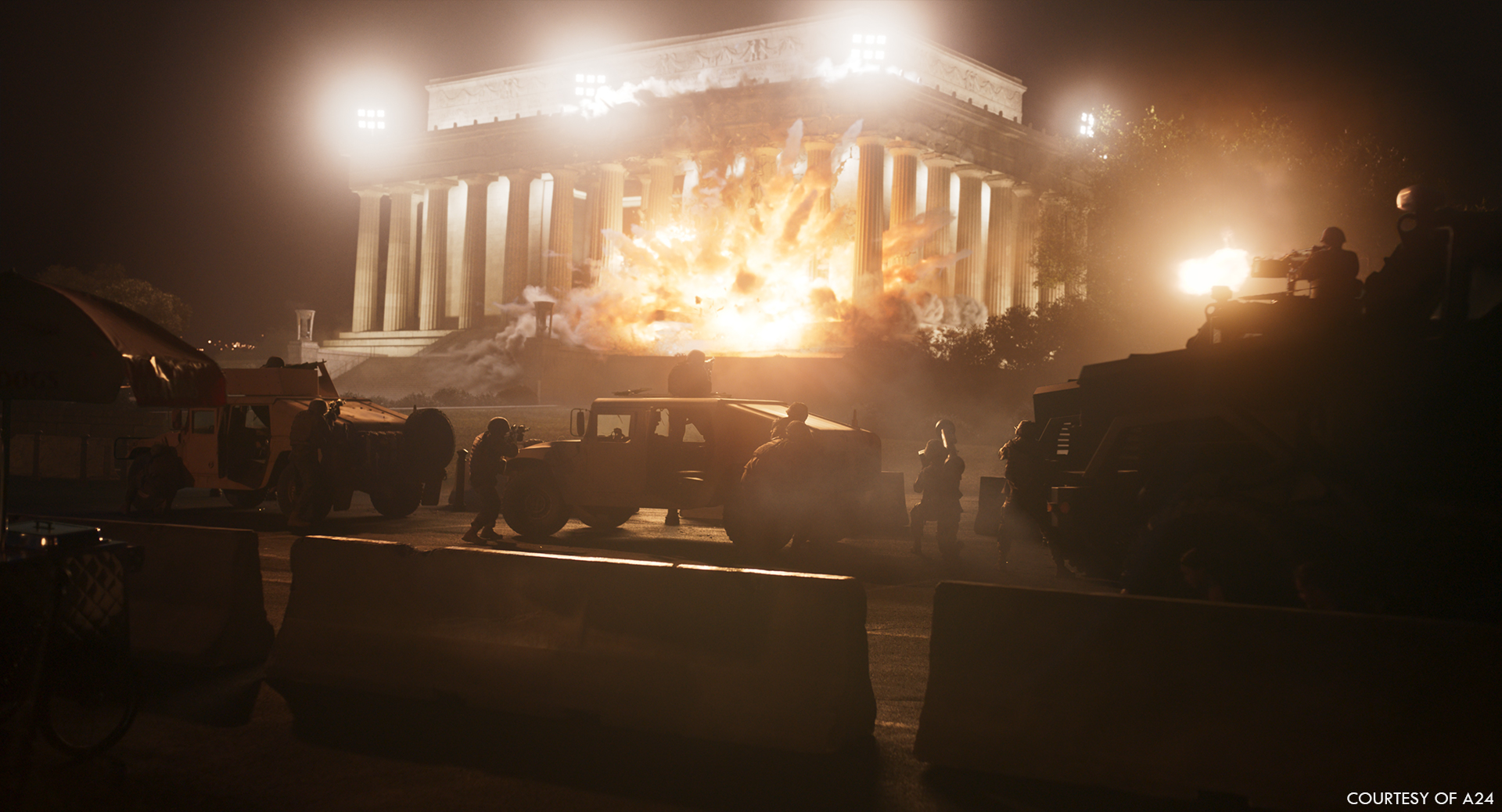
Can you elaborate on the specific techniques used to recreate New York and Washington?
Originally, we planned to shoot plate photography for the Washington DC aerial shots. However, the CG build was looking great, so we embraced it and took the full CG route. This gave more creative flexibility. Filming over Washington DC comes with a lot of restrictions and limitations – especially around the White House.
So, every time there’s a shot in a helicopter over Washington DC, you’re looking at a fully CG city. Every pixel.
Post Production for Civil War was based in London and I remember walking down the street one evening and looking up at the buildings. Every office was slightly different, it had a different layout or interior design. Even subtle differences – like different companies must buy different light bulbs, so some floors have a warmer tint than others. Then there were cranes with blinking red lights in the distance, buildings covered with scaffolding, roadworks. The sort of things which are often overlooked when creating digital cities.
We approached our city with the aim to stuff it with as much life and detail as possible.
Our city’s traffic lights work – they’re programmed to a pattern. Street lamps have variations in bulbs. Every office has an interior – containing desks with monitors and keyboards, whiteboards, posters, potted plants. The offices even have emergency exit signs, air conditioning vents. There are ground floor shops with displays in the windows.
Then there’s the war element: streets have barricades, traffic jams, craters. Some windows and walls have bullet holes and others have been boarded up. Some buildings are on fire, or just smouldering. There are mocap soldiers in skirmishes in alleyways. Police Cars and Humvees race through the streets. There are tank convoys, and MRAPs.
It’s a full, living, breathing, city at war. The care and attention to detail that went into it is astounding. Framestore didn’t just build a City, they built a full warzone – inside and out.
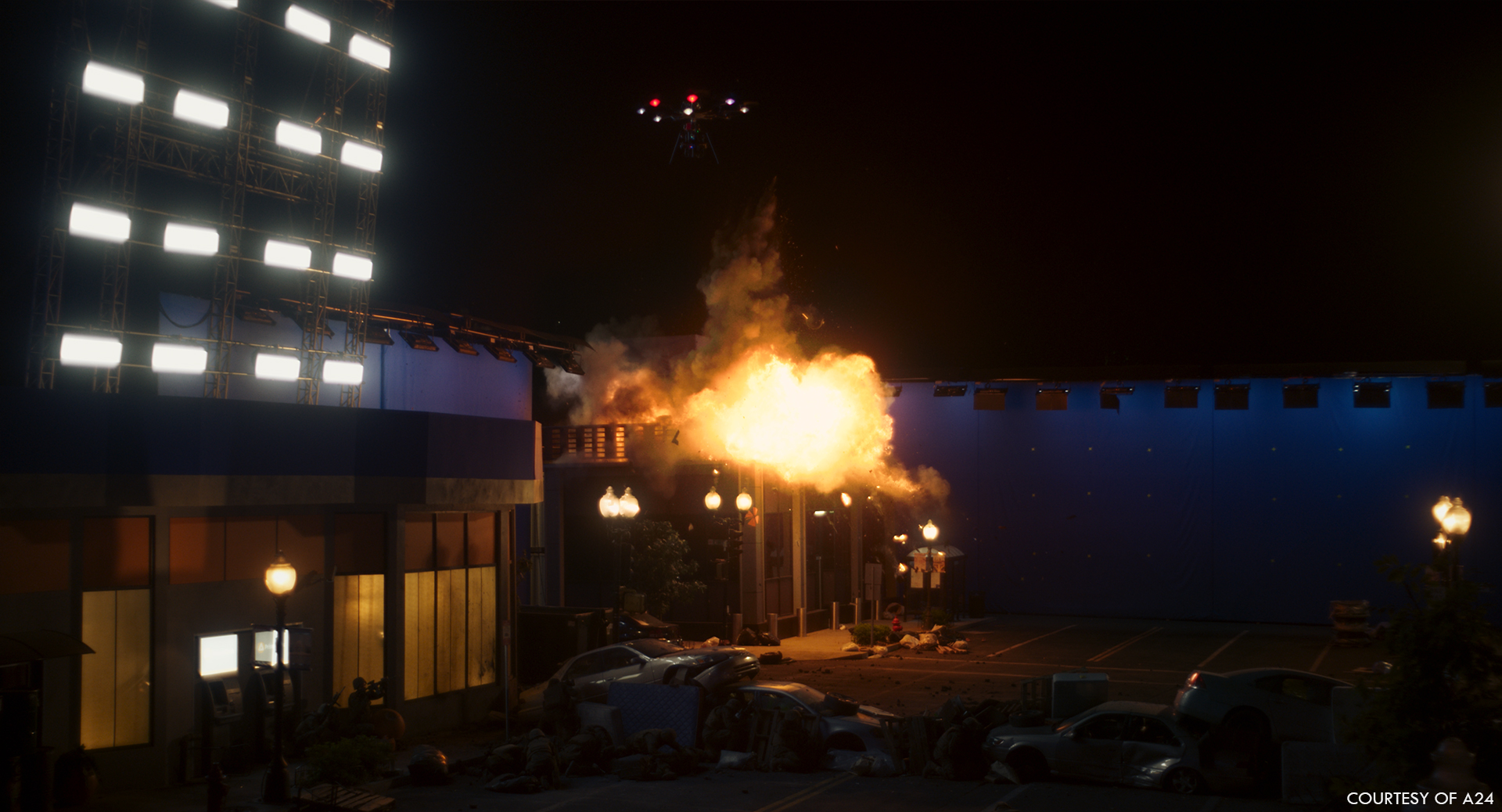
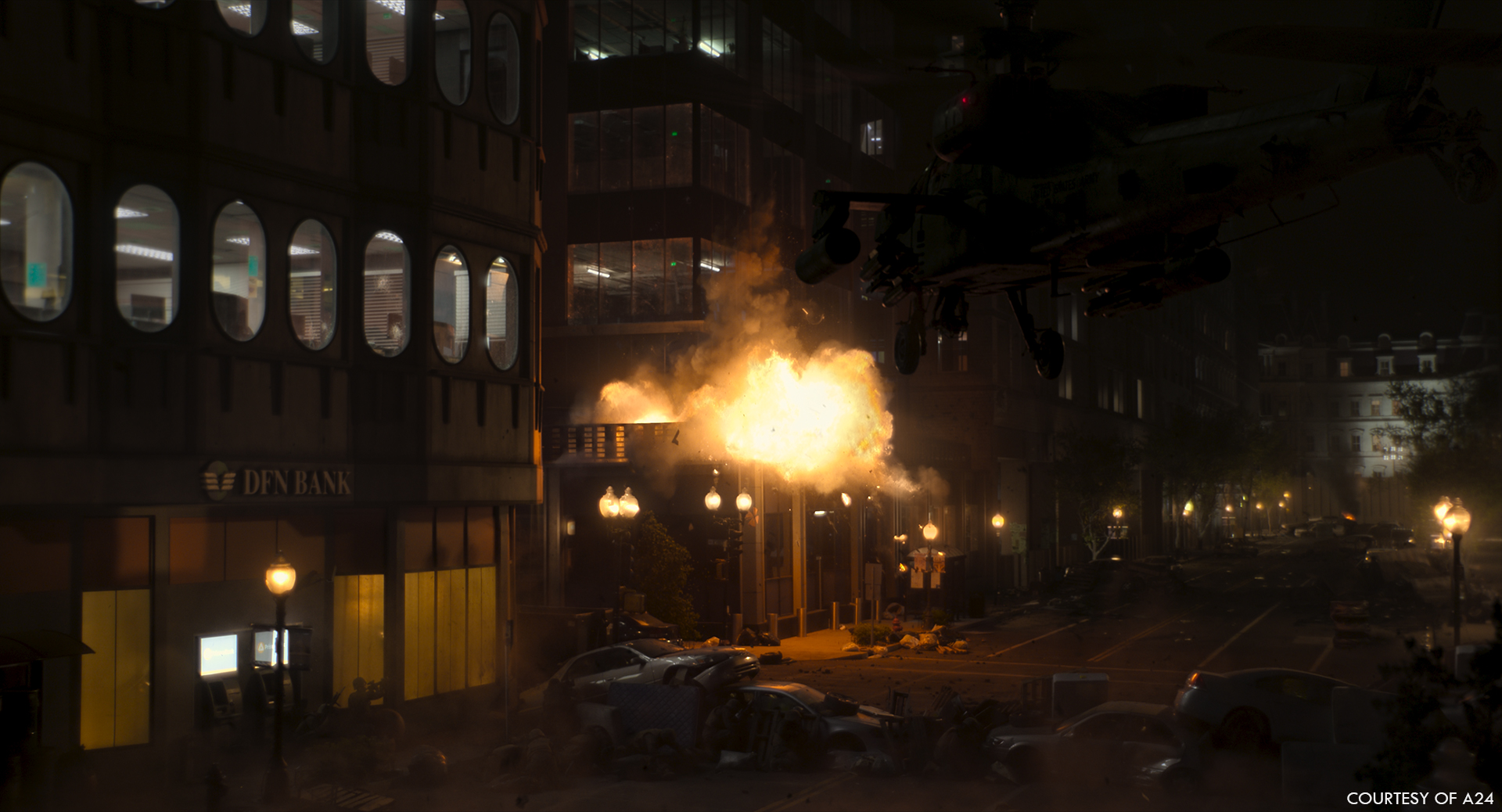
What challenges did the team encounter during the process of transforming Atlanta into these major cities, and how were they overcome?
Sometimes the transformation was straightforward.
Brooklyn, for example, is an intersection in Atlanta with a few establishing shots of Manhattan’s skyline in the distance. Using the internet, we scouted a suitable hero street in Brooklyn and a colleague based in New York took some photographs of the view for us.
Other times, like with Washington DC, it was a bit more involved!
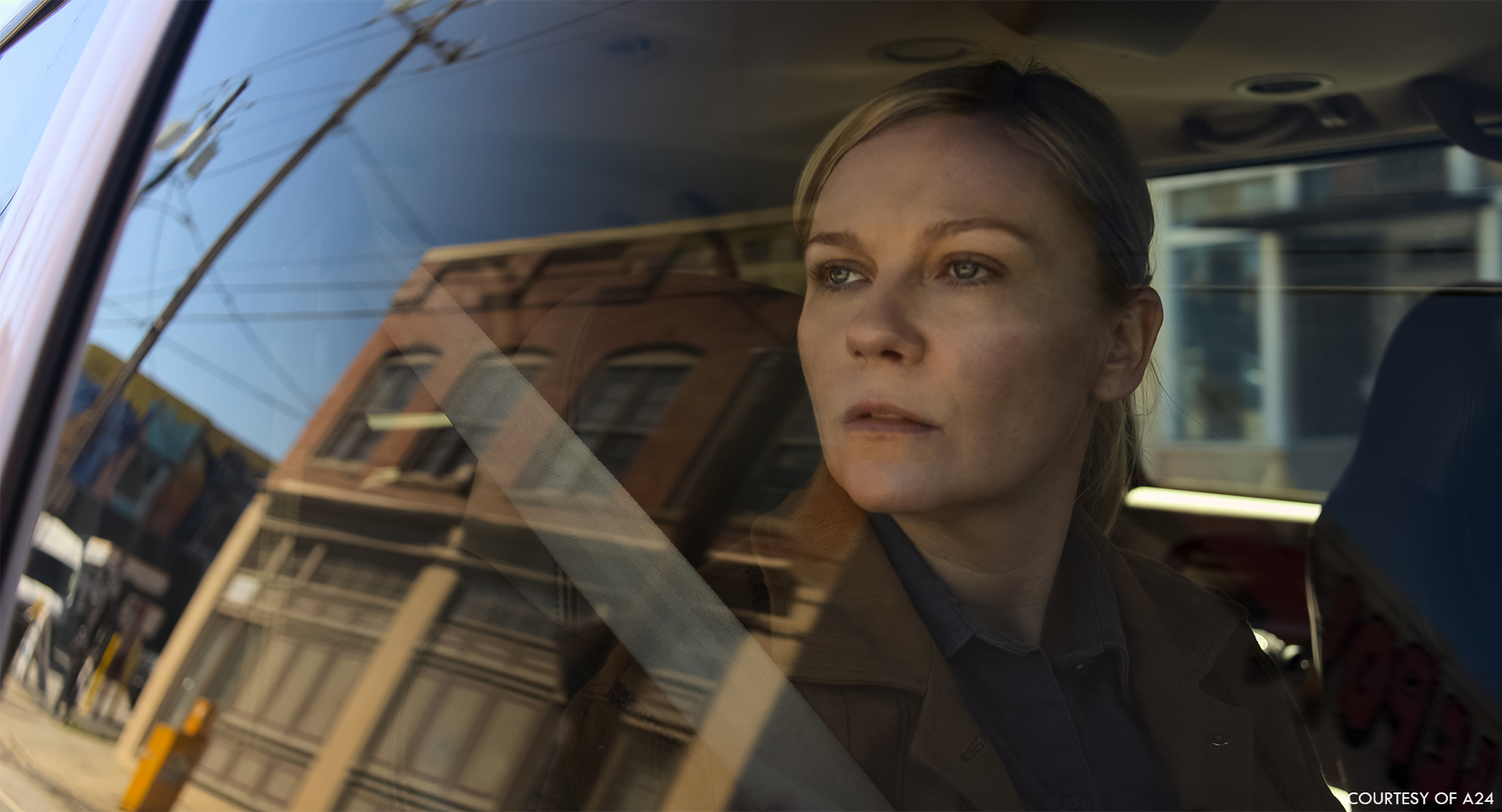
In depicting the White House, what attention to detail was necessary to ensure authenticity while filming in a location significantly different from Washington, D.C.?
There are actually three White Houses in the film. There’s an interior set, built on a stage (used for the corridors and offices). There’s the 75% scale White House at Tyler Perry Studios (used for the shots where characters run up steps and enter the lobby). Finally there’s our CG White House (used for everything else).
Our CG White House is actually slightly to scale too. When Chris Zeh and I came to mark out the route for the stunt Vehicles to drive, we realised the car park was too small. So the grounds of the digital White House and the Eisenhower building are shrunk a little to compensate. We wanted real cars skidding across real tarmac, so that meant shrinking our White House by a tiny amount. We’re talking 5-10%.
Given the complexity of simulating urban environments on screen, what collaborative efforts were undertaken between the visual effects artists and other departments to maintain consistency and believability throughout the production?
There was a lot of collaboration when it came to DC. We had a number of meetings standing in that Yellow Daisy Parking lot – gathered around diagrams and maps.
It was a large build and time was short. Every department worked together to determine where best to focus resources. We took into account where the action was staged and where was the camera pointing, to decide how much set was required.
Luckily, because everything was based on a real city, we always had something to compare to. We could bring up real images of these locations in Washington DC and cling to those.
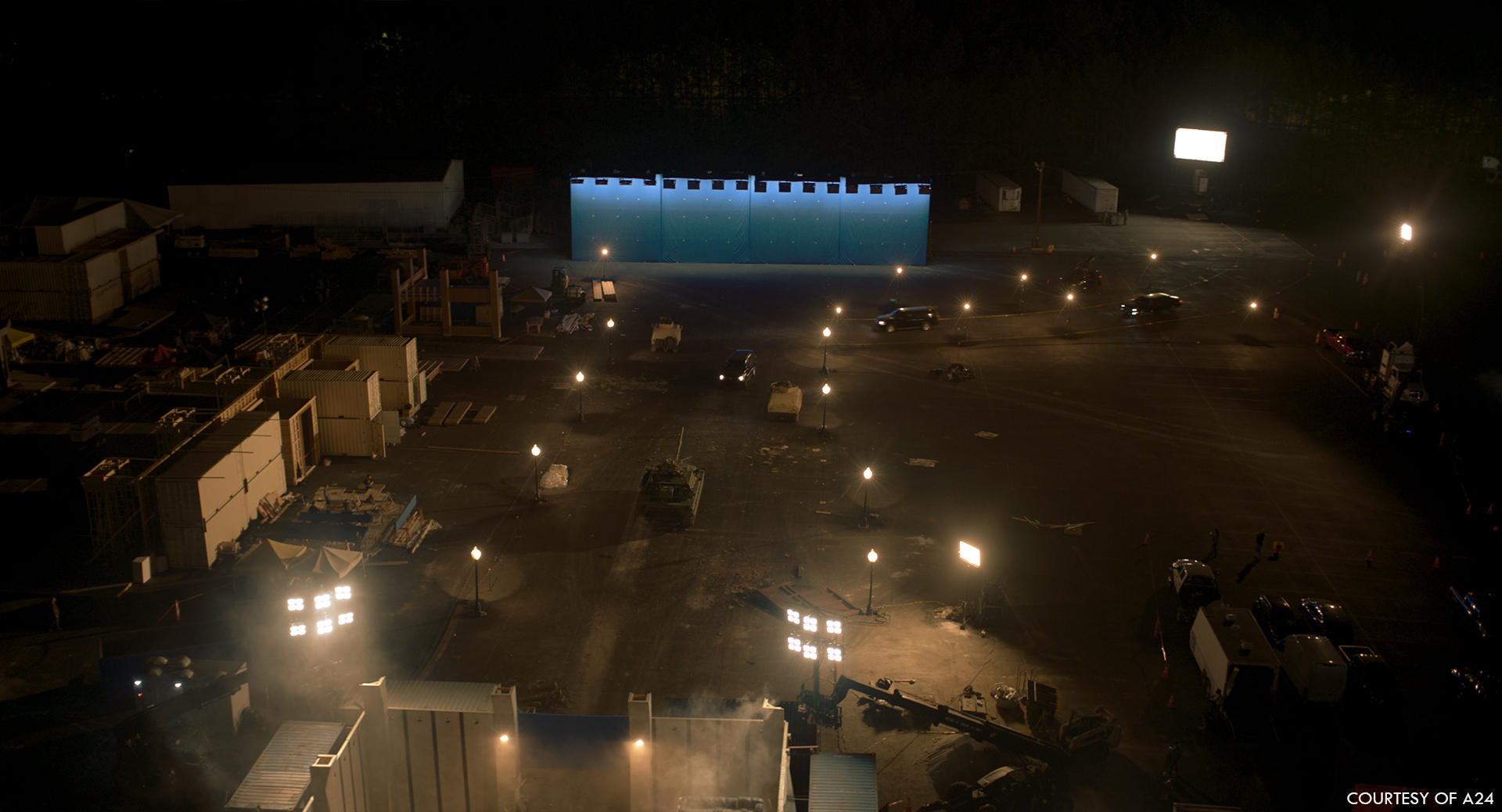
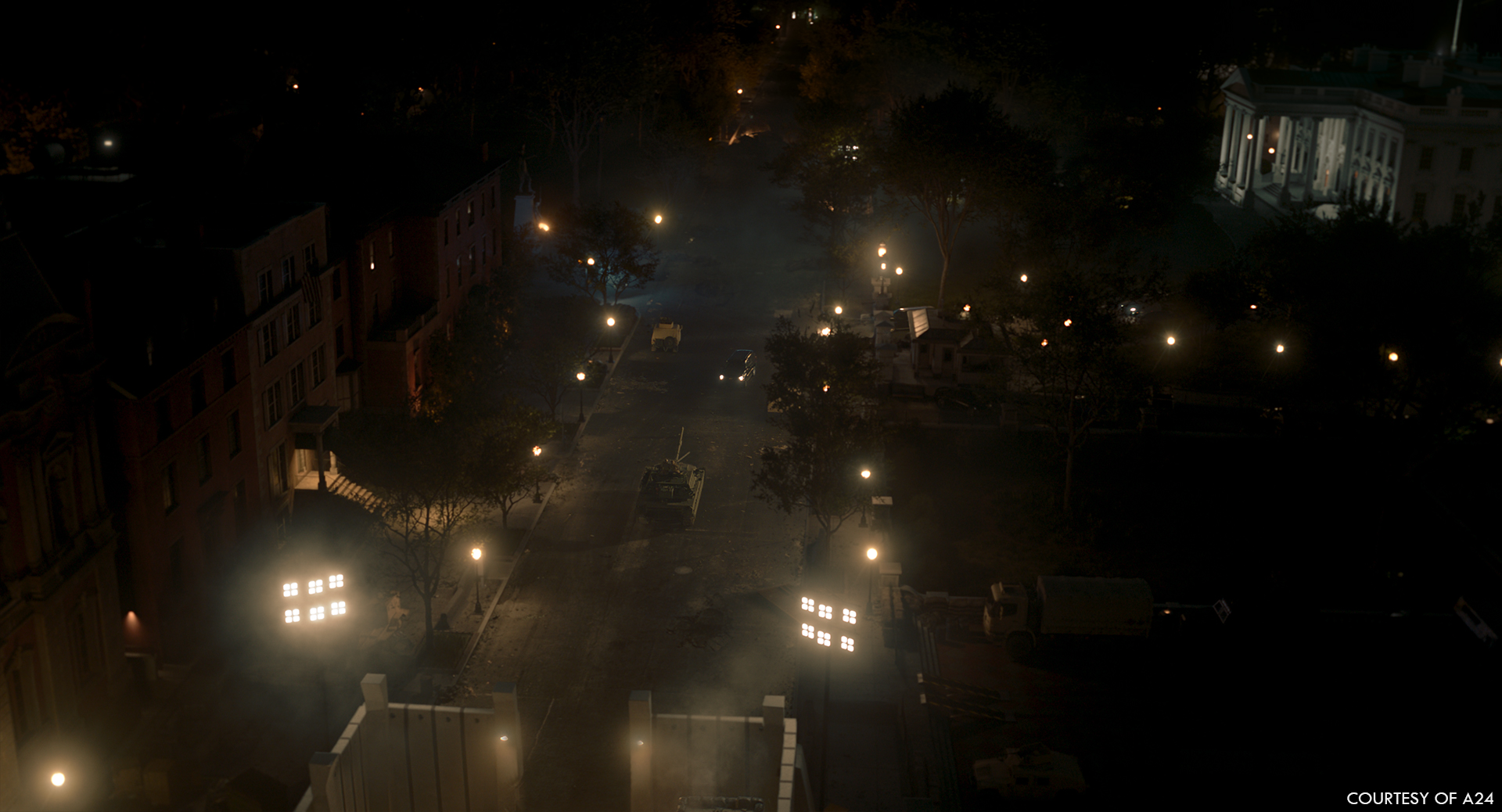
Which location was the most complicate to create?
Washington DC, definitely. While we shot it across three localised sets, the CG asset itself was one whole city.
The hardest part with Washington DC was squeezing more and more realism out of it. Looking for details and ways to ensure the audience believes it’s real.
One of the ways we managed this was to incorporate things you wouldn’t think to do in a CG city – those mundane details and flaws. I mentioned cranes and scaffolding earlier, things like that. One of my favourite instances of this came purely by accident.
On 17th street, there’s a CG building on our intersection with round windows. One day, one of our Environments leads, Matt Chandler, showed me a work in progress and said “Please ignore the round windows, something broke – but we’re going to fix them”.
I was like: “Or… maybe we keep them?”
The beauty of those round windows is they can’t possibly be CG, right? Why would anyone go to the trouble of making round windows for a single building in a CG city? It’s the sort of detail an architect chooses in the 1970s, but would never occur to a VFX team in the 2020s.
I showed Alex and he felt the same way – so they stayed. That mistake is there forever now – sorry Matt, I still love the round windows!
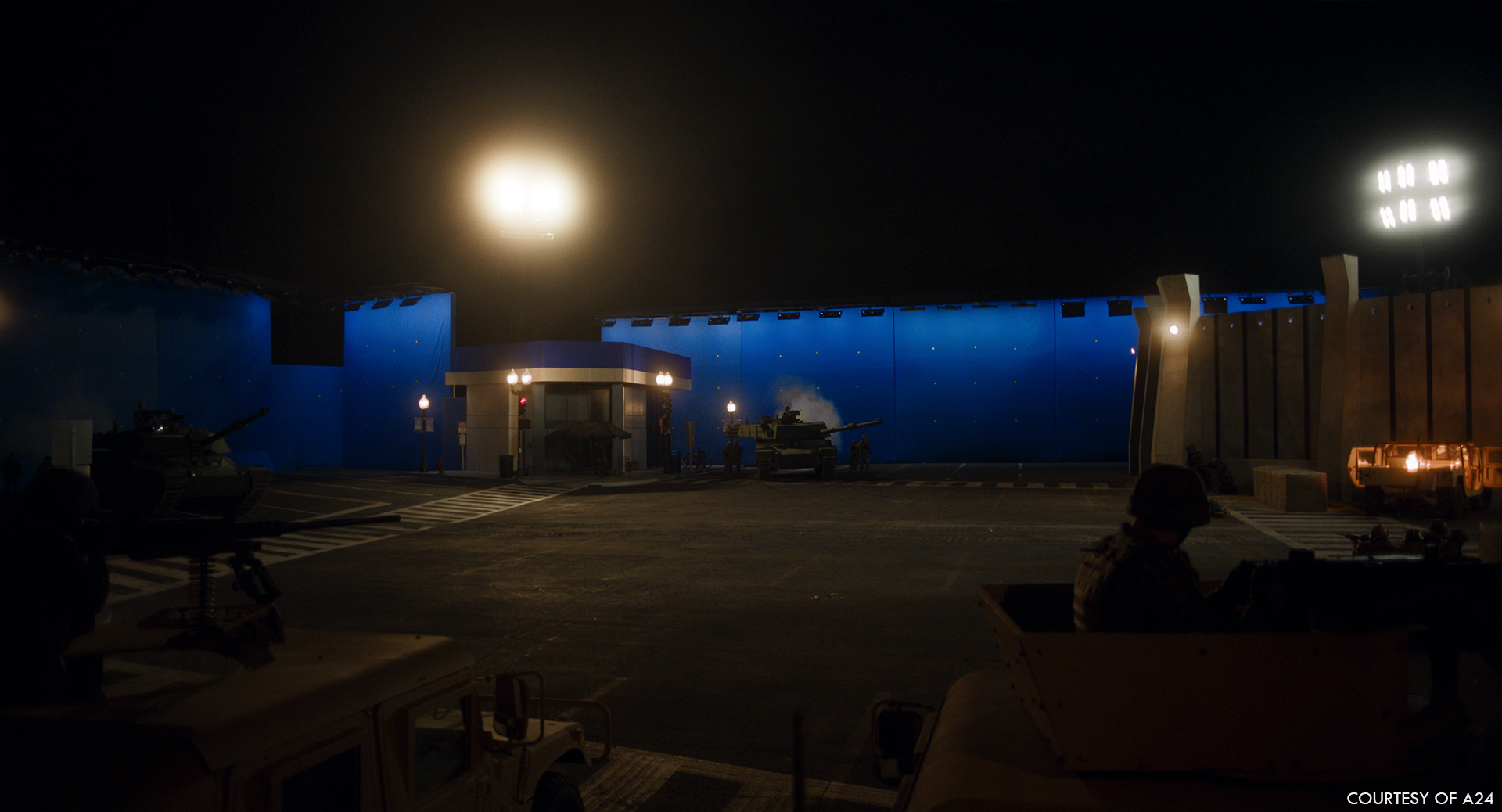
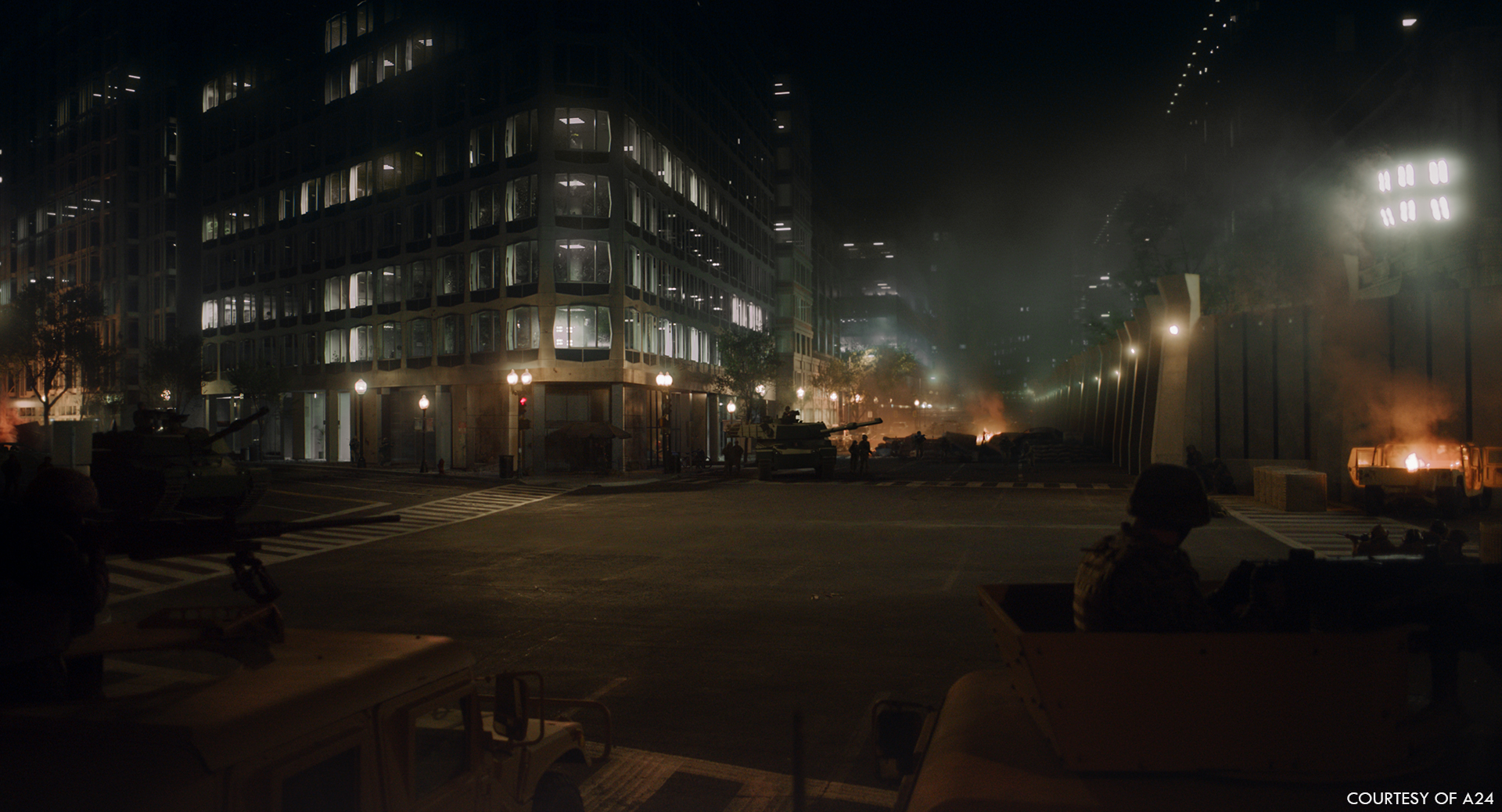
Can you walk us through the key steps involved in designing and animating these vehicles to achieve authenticity on screen?
In my experience, the hardest things to animate are the things we see everyday. Faces, hands, cars. We’re tuned to understand them, which makes our subconscious hyper sensitive.
We tried to make sure all of our vehicles behaved in a realistic way. They never do a stunt that a real pilot or driver couldn’t perform. Even the Apache helicopter on 17th Street (which is probably the most dangerous stunt) a good pilot could have performed. Though they might have blown our set away!
We also tried to have real vehicles in frame as much as possible – to have a genuine reference to match to. For example, at the Western Forces base, we had lots of real tanks, Humvees and MRAPs, but not enough to fill the space. We tried to always use real vehicles in the FG then extend the convoy into the distance with VFX. As soon as you couldn’t tell where the real vehicles stopped and the CG ones began, you were onto a winner.
I think by switching up between CG vehicles and real vehicles, it becomes harder to spot the differences. Sometimes it’s CG, sometimes it’s real, sometimes it’s both. You keep the audience guessing.
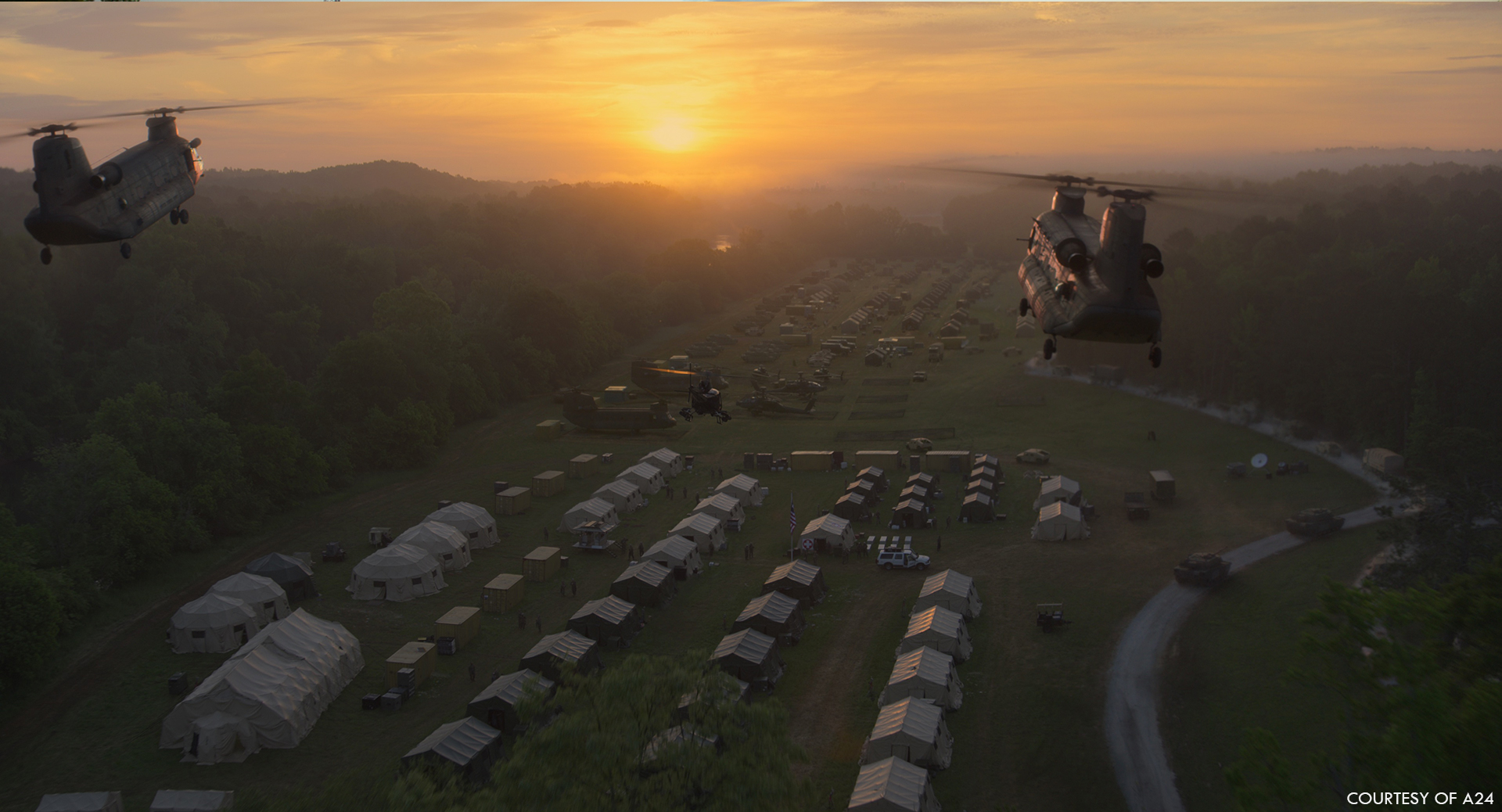
How do you approach the creation of realistic flight sequences for aircraft, helicopters, and other vehicles?
In case I haven’t rambled on about it enough, we were obsessed with references on this film! We found references for everything.
For the full CG Helicopter shots, we took a mixture of stock helicopter footage over Washington DC with real Helicopter shots captured during the shoot.
Fred North and his team shot a number of helicopter plates for Civil War and their work was incredible. The footage was really energetic and beautiful. We used those as a guide for speed, movement and altitude, then referenced the stock photography over Washington DC for framing, lighting, exposure.
When you have a CG camera, the options become infinite. It can go anywhere and do anything – but that wouldn’t have been in keeping with the language of the film. We wanted our CG cameras to feel like they were in the hands of a human operator.
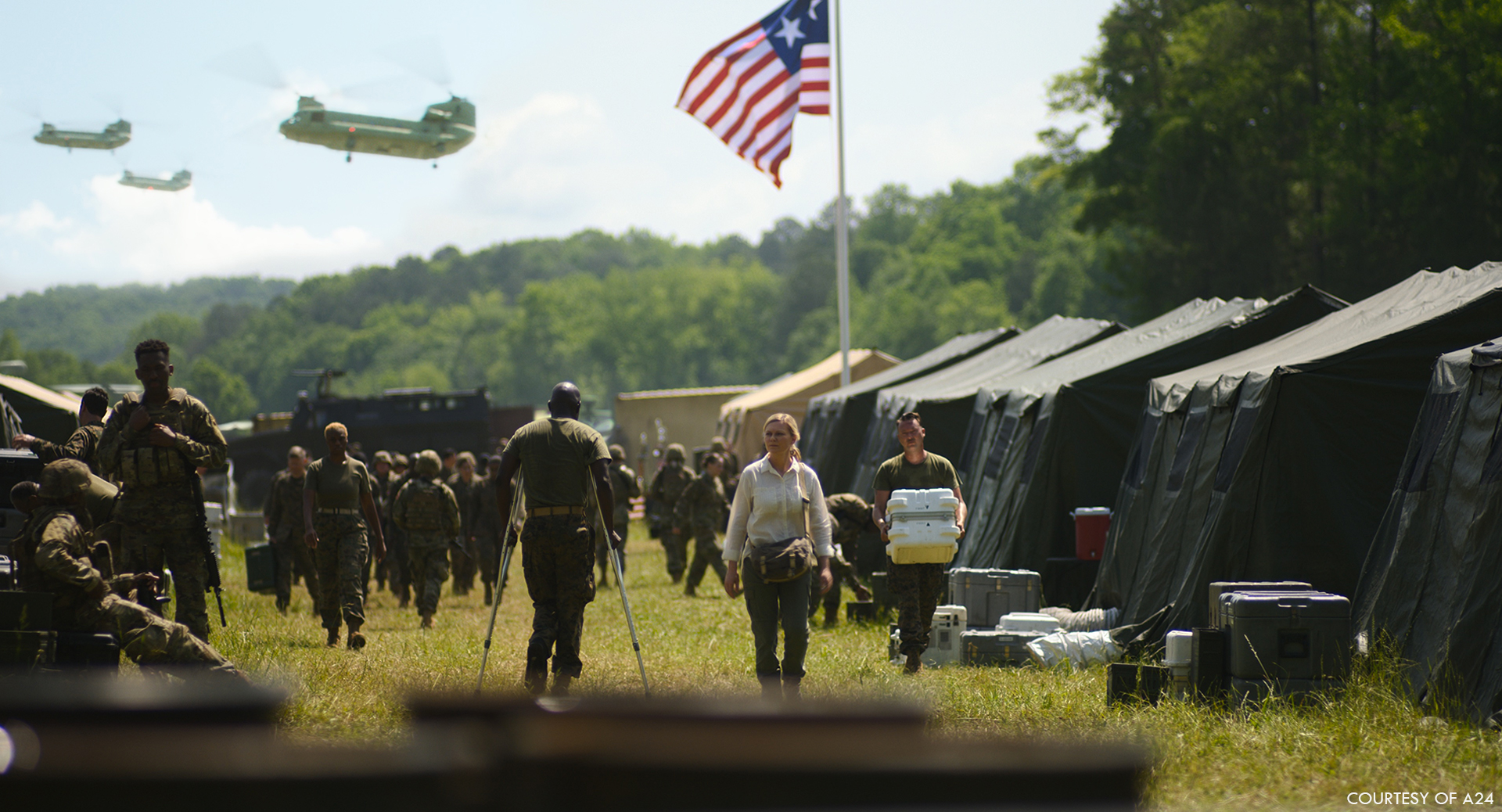
Could you elaborate on the creative process behind crafting the visually stunning forest fire sequence?
I wish I could take credit for this! This is all SFX. J.D Schwalm and his team came up with an incredible forest fire setup.
They safely hid flame trees (a metal tree shaped structure) in clearings through the forest and pumped in smoke which Rob lit with orange light. The embers came from an ember machine mounted to the back of a truck. We drove back and forth down a long stretch of road in a three car convoy. The follow car first (with monitors, which a few of us sat in), followed by the ember truck pumping out embers, followed by the actors in the hero vehicle at the rear.
Honestly, 90% of that sequence is entirely in camera. VFX added tree trunks and branches to the metal flame trees and added CG embers on two shots (where the distance between the vehicles got a bit wide). But other than that, it’s all SFX and in camera. It was magical to film – everyone riding along in the follow vehicle had goosebumps.
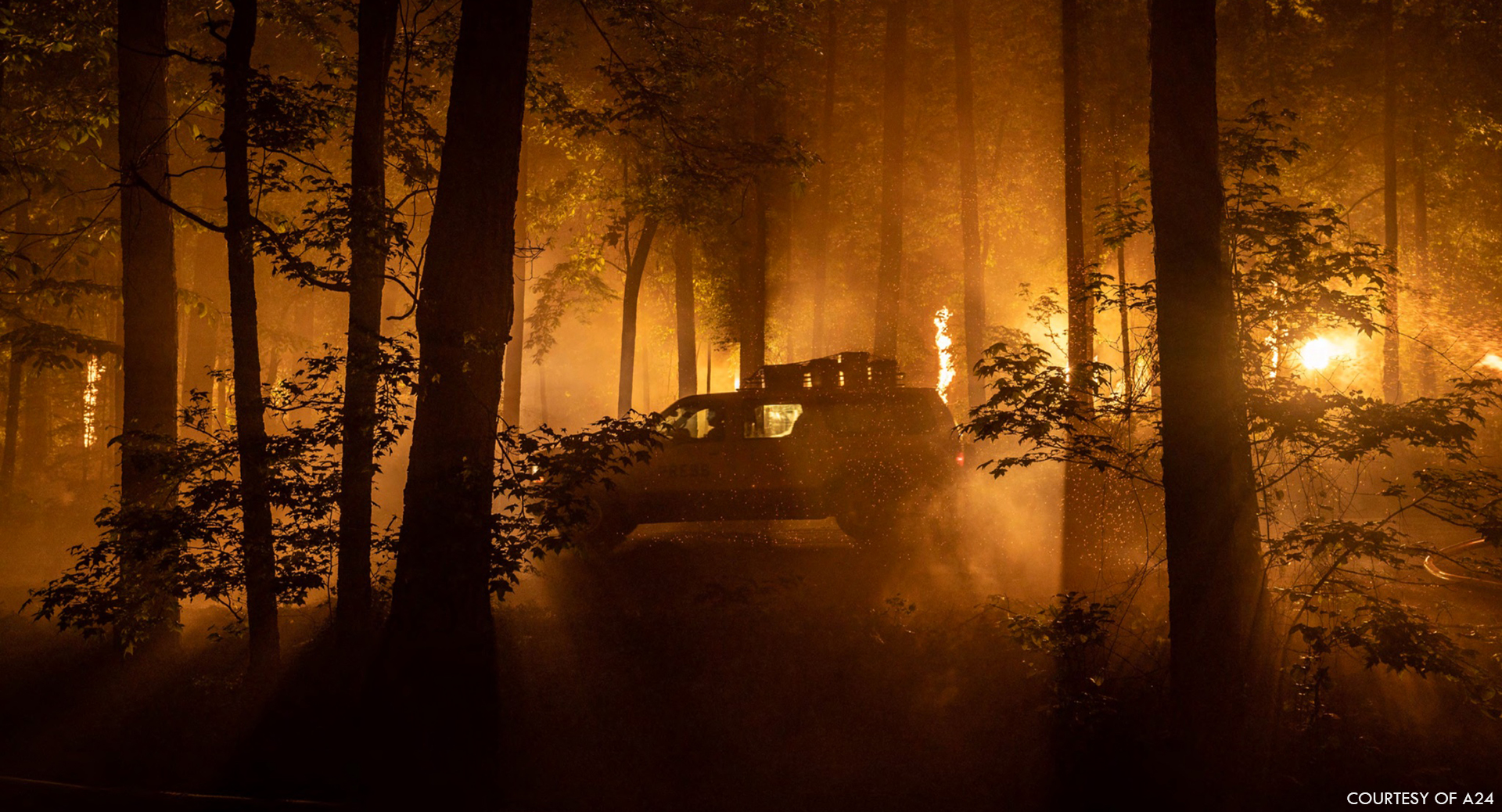
Can you discuss the inspiration behind the visual design choices for the forest fire sequence, including any references drawn from nature or artistic influences?
We looked at real footage in preparation, but again – I wish I could take more credit! It looks great!
There’s an aerial shot at the start of the sequence. That’s plate photography from the helicopter team with Framestore adding the fire in VFX. We found references for that shot and discovered that most forest fires are shaped like a ring. There’s a leading edge of flame at the front, like a wall, but everything behind has burnt out.
I love how that shot turned out, it’s really beautiful.
Were there any memorable moments or scenes from the movie that you found particularly rewarding or challenging to work on from a visual effects standpoint?
I really like the work as a whole. We worked really hard to give it a unified feel. On this film, more than others, I feel the shots blend together into one whole. They complement each other.
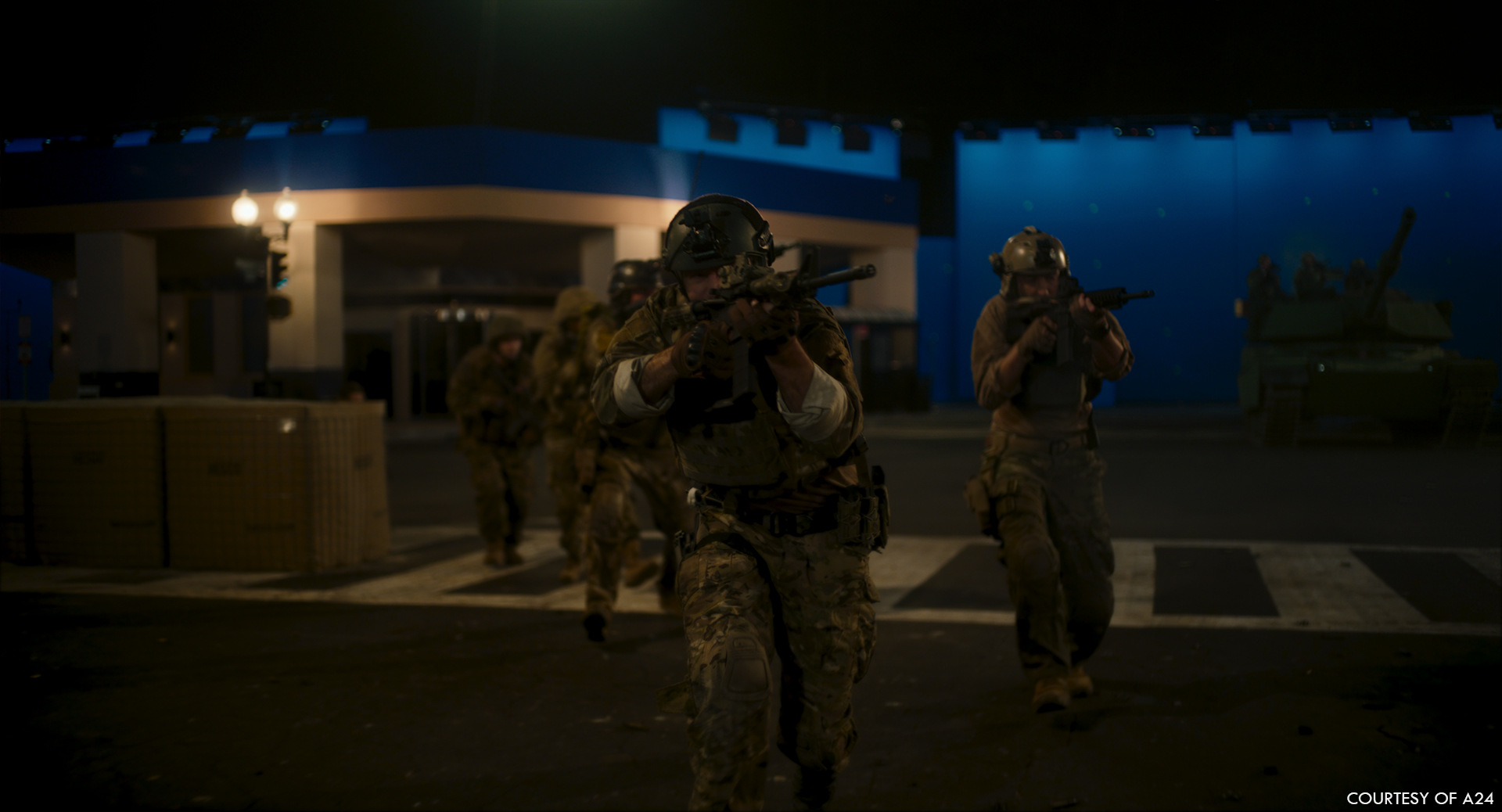
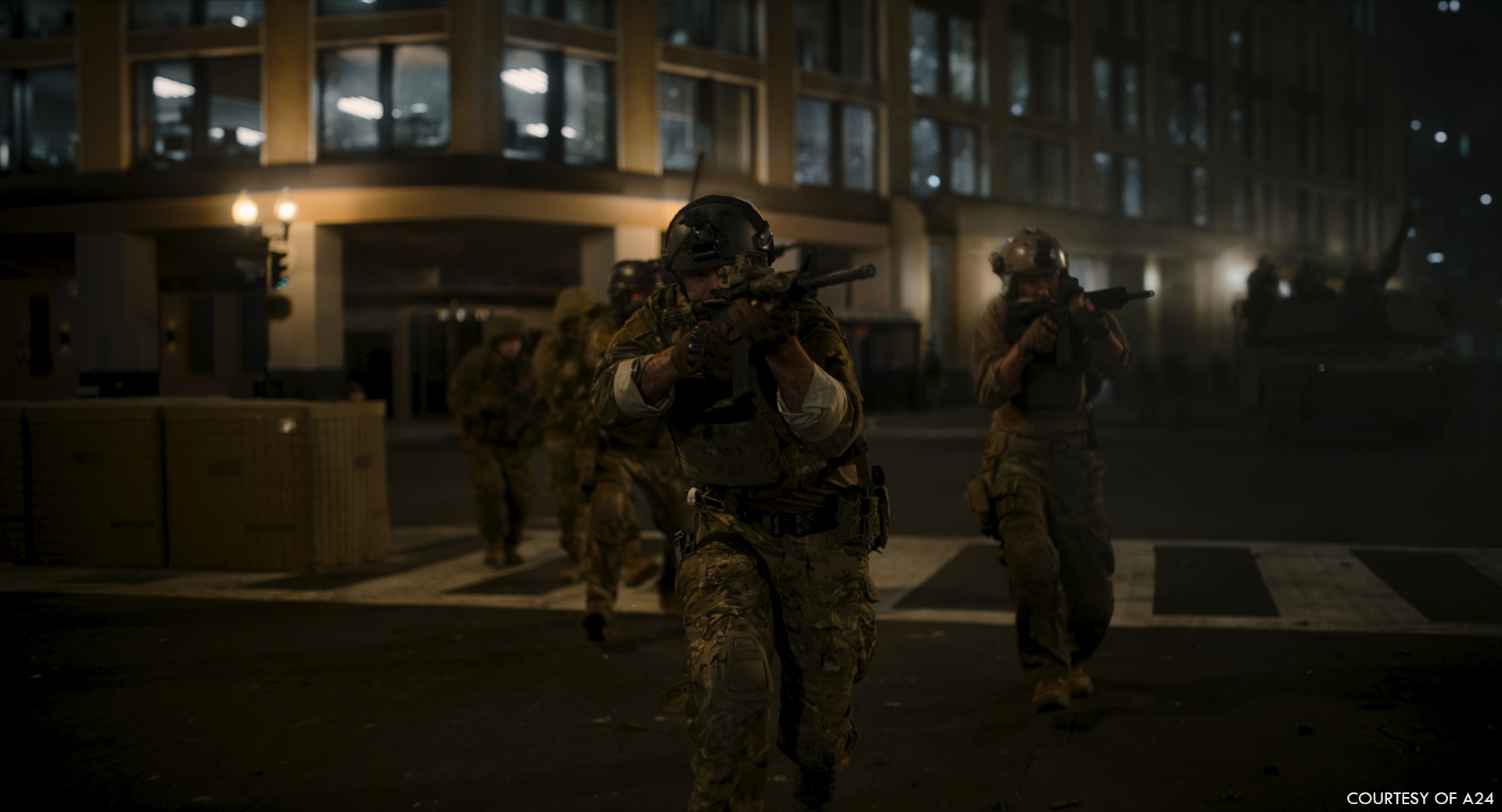
Looking back on the project, what aspects of the visual effects are you most proud of?
We had a really small team – far fewer VFX artists than the average film. However, by being a skeleton crew, we were able to foster a creative environment. It allowed everyone to voice ideas and really invest in the project.
Tricky question, what is your favorite shot or sequence?
It would be easy to say one of the big ones, but often my favourites are the “throwaways”. The ones which I forget are VFX shots – those are the best. I love being fooled by VFX, so the ones that are so seamless they fool me even after I’ve seen them 100 times – those are my favourites.
How long have you worked on this project?
I started towards the end of 2021 and I think we delivered our last shot in June 2023.
What’s the VFX shots count?
Around 1000 shots, split between Framestore, TPO and FIXFX.
What is your next project?
I’m not sure I’m allowed to say yet. Sorry!
What are the four movies that gave you the passion for cinema?
Well, let’s not beat around the bush: Jurassic Park is the best film ever made. That’s not opinion – we all know it’s true. But I also have a fondness for The Marx Brothers, Kevin Costner movies and anything by Aaron Sorkin.
A big thanks for your time.
WANT TO KNOW MORE?
Framestore: Dedicated page about Civil War on Framestore website.
© Vincent Frei – The Art of VFX – 2024
Dive deep into the heart of the action with our exclusive behind-the-scenes footage of the Panama Canal sequence (with the VFX made by Scanline VFX) from Episode 5 of Netflix‘s thrilling series, 3 Body Problem:
The VFX are made by:
BUF (VFX Supervisor: Dominique Vidal)
El Ranchito (VFX Supervisor: David Ramos)
Image Engine (VFX Supervisor: Thomas Schelesny)
Pixomondo (VFX Supervisor: Sven Martin)
Scanline VFX (VFX Supervisors: Boris Schmidt and Mathew Giampa)
SSVFX (VFX Supervisor: Ed Bruce)
The Production VFX Supervisor is Stefen Fangmeier.
The Production VFX Producer is Steve Kullback.
The Associate VFX Producer is Paul Russo.
Director: Derek Tsang
Release Date: March 21, 2024 (Netflix)
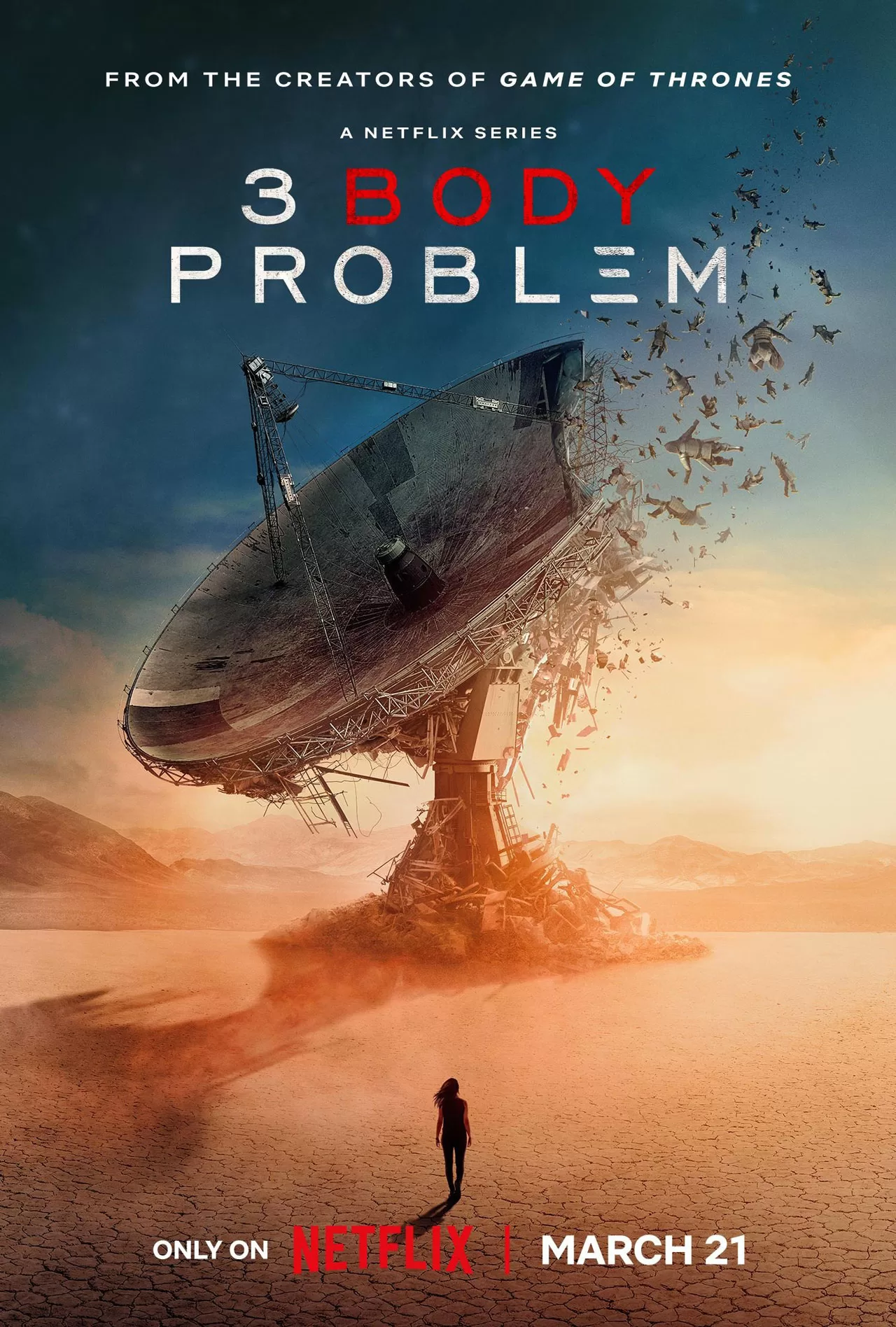
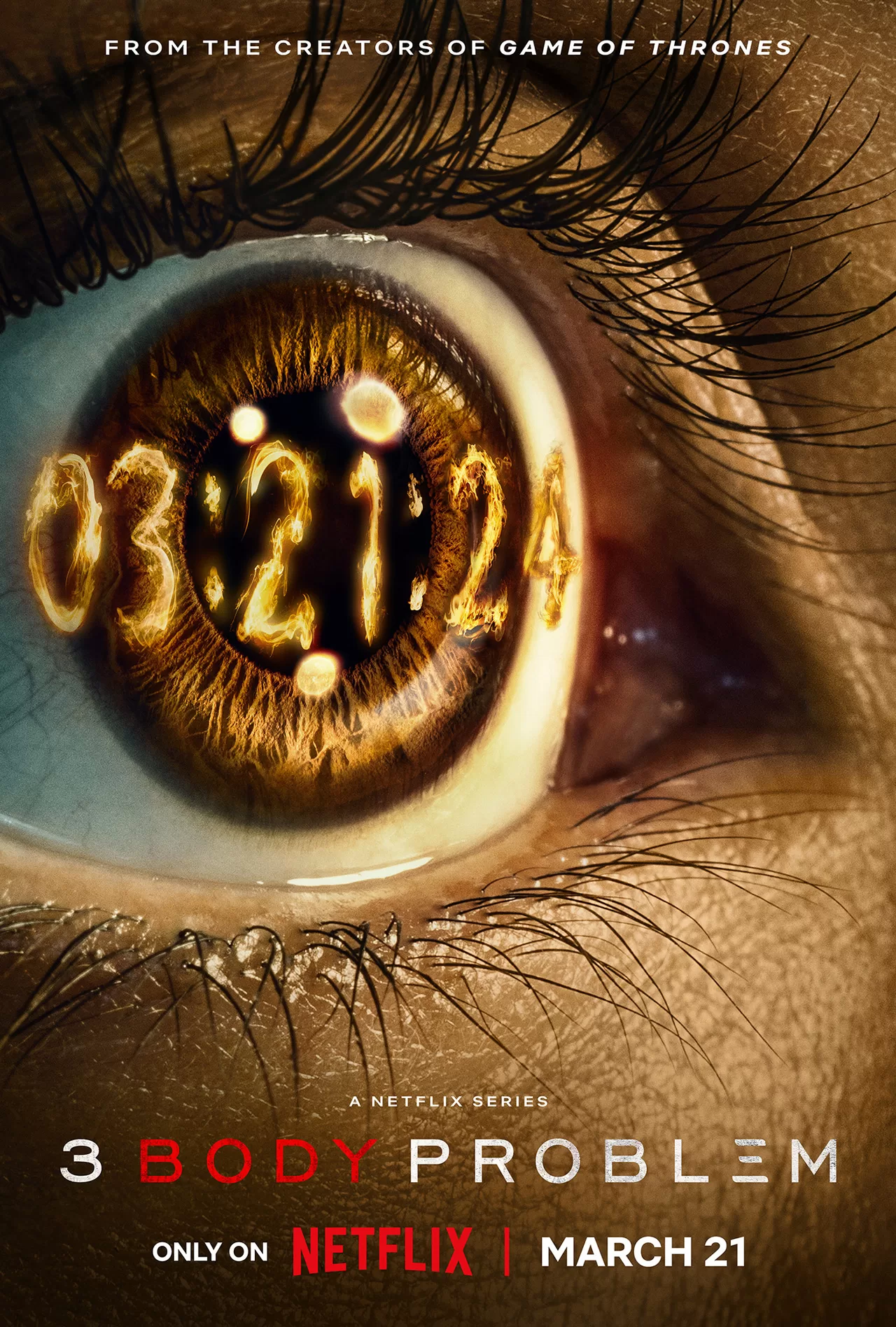
© Vincent Frei – The Art of VFX – 2024
Embark on a journey with the Johannesburg-based studio alphaVFX as they unveil their invisible visual effects made for the series, Shaka iLembe:
© Vincent Frei – The Art of VFX – 2024
Transport yourself to the heart of the Hungarian Revolution with the visual effects made by Ionart Studio who has meticulously recreated the atmosphere and intensity of this historic event for the film Now or Never!:
WANT TO KNOW MORE?
Ionart Studio: Dedicated page about Now or Never! on Ionart Studio website.
© Vincent Frei – The Art of VFX – 2024
Discover the artistry of the visual effects crafted by the Munich-based studio BigHugFX for the Netflix live action adaptation of Avatar: The Last Airbender:
WANT TO KNOW MORE?
Netflix: You can now watch Avatar: The Last Airbender on Netflix.
© Vincent Frei – The Art of VFX – 2024
Reflecting on 2021, Olivier Cauwet enlightened us about his visual effects endeavors on the film Eiffel. Now, he sheds light on his new collaboration with director Martin Bourboulon, detailing his involvement in both installments of The Three Musketeers.
How did you feel about working on a new adaptation of The Three Musketeers?
As I was finalizing the film Eiffel, Martin Bourboulon (the director) shared his enthusiasm for his next project. It was an ambitious venture with a stellar cast, a two-part adaptation of Alexandre Dumas’ “The Three Musketeers,” and he wanted me to join the team. This XXL project led us on an equally captivating journey both on-screen and in its realization. It wasn’t just the adaptation of the novel that struck me, although it’s a French literature classic, but especially the opportunity to immerse myself in the “cape and sword” genre, something I had never done before, and that we hadn’t seen in France for years.
Of course, I read again the novel, but it was Martin’s vision, Alexandre De La Patellière and Matthieu Delaporte’s adaptation, as well as Dimitri Rassam’s enthusiastic energy that propelled us into this journey. As I mentioned, it was truly an adventure in itself, with a shoot that spanned 139 days for the two parts D’Artagnan and Milady. We even mix the filming, where, depending on the sets, we could shoot scenes from both films on the same day.
How was this new collaboration with director Martin Bourboulon?
For his previous film, which had a significant amount of VFX, our first collaboration went very well. With this new project, Martin Bourboulon and Dimitri Rassam wanted to maintain that continuity, keeping the same spirit and trust in BUF for visual effects. Martin gives a lot of freedom to his entire team, which makes the experience extremely enjoyable. We truly feel involved at every stage, whether it’s during preparation, filming, or even editing. Martin communicates his vision, his impressions of what he wants to feel, the pace, and his directing intention. He’s always open to suggestions, allowing for real freedom of choice, while having a clear idea of what he doesn’t want. It’s a collaboration where the exchange of ideas and active participation in creation are highly valued.
What was his approach and expectations about the visual effects?
Visual effects must meet Martin’s high expectations, as he doesn’t want effects that overshadow the action or narrative. They are a tool for realization and must blend into the scenery, remain invisible, and I completely align with this vision. Martin likes to challenge his teams, and VFX is part of that. So, you always have to find a way to meet his directing expectations.
The shooting was done with an AlexaLF, 1960s anamorphic lenses, SerieC Expanded from Panavision, and a chocolate filter for the hue. Alive, always in a dynamic style, the camera is constantly in motion.
How did you organize the work with your VFX producer?
Simon Beausoleil is the VFX producer for both parts of The Three Musketeers. We organized the VFX shot production schedule in accordance with the editing process and established a delivery schedule for sequences based on their complexity and production time. The editing team had to deliver them to us as a priority to meet the post-production deadlines. We enlisted the help of two other VFX studios to assist us with each part. The Three Musketeers have a total of 806 VFX shots, with 637 distributed among BUF, CGEV, and Mac Guff. CGEV worked on the shots involving ‘d’Artagnan’, and Mac Guff handled those of ‘Milady’. A fourth VFX studio, IIW Studio in Lux laboratory’s offices, worked separately on 169 VFX shots.
How did you choose these studios?
BUF expressed a desire to collaborate with CGEV. Therefore, we proposed a collaboration with them on ‘d’Artagnan’. David Brochard supervised their work, and Marion Frelat was their producer. For ‘Milady’, it was natural for us to turn to Mac Guff, with whom we had previously worked on Eiffel. I wanted to relive that experience. Dan Rapaport supervised their work, and Mathilde Sonrier was their producer.
Can you tell us how you divided the work between them?
We decided to assign each studio one of the two films so they could take ownership of the project. CGEV took charge of the first part, ‘d’Artagnan.’ They handled the opening sequence in the rain, worked on extending the streets of the Musketeers’ hotel, created CG crowd scenes to enhance the extras, and dealt with various elements such as cleaning up anachronisms and touching up sets, thereby contributing to the visual aesthetic of the film.
As for Mac Guff, they worked on ‘Milady,’ the second part. Their involvement included several continuous shots, including the fight between d’Artagnan and Ardanza, as well as the final battle between d’Artagnan and Milady in the burning outbuilding. They also removed anachronisms and made set touch-ups.
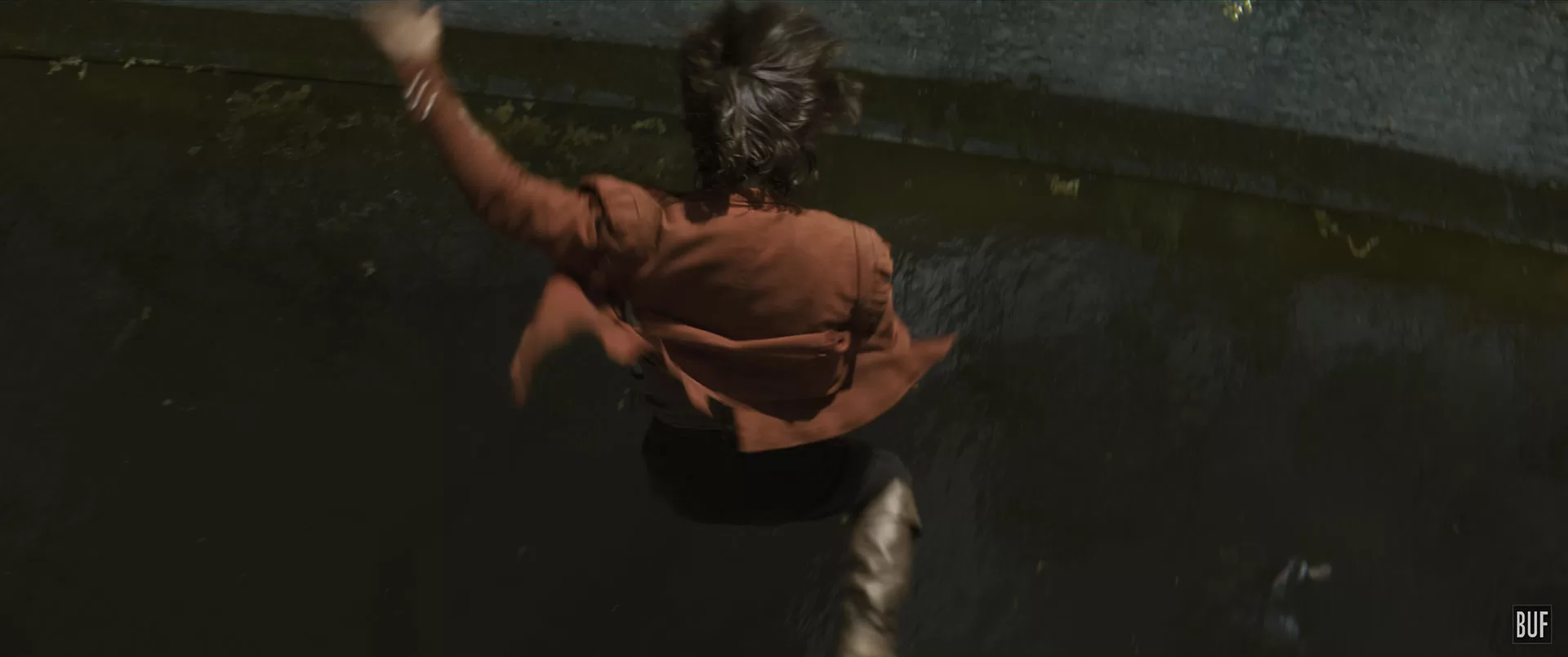
What was a typical day for you during filming and post-production?
During the 8-month filming period, I was nearly there every day. I was called in with the direction team to prepare for the day. Even though most major issues were sorted during location scouting, there were always adjustments to be made due to changes or new ideas. I was primarily in contact with Carole Amen and Juliette Crété, the first assistant directors, and their teams, as well as Nicolas and Martin.
Overall, I was alone on set, my equipment traveling with me in the camera truck. In addition to my supervisory work, I gathered camera information, took necessary photos on set, HDRI with the Theta, and I had a small Leica Lidar with me, so I also scanned the sets. But on large sets like Compiègne or Saint Malo, where there were two teams, I enlisted the help of Aurélien Marquaille to assist me and gather data (set and extras photos, Lidar, HDRI, etc.). There’s also Marion Eloy, an artist I’ve been working with for a long time, who accompanied me for 2 days on the cliffs shoot in Etretat.
During filming, for marketing and production reasons, we had to urgently start VFX work on the continuous shot of ‘d’Artagnan’ fighting alongside the three Musketeers in the St Sulpice forest. We had to deliver it before the end of filming. So, I supervised the work daily from the set, and Marion Eloy oversaw the team in Paris. I was with Martin daily, so I could show him progress regularly.
At the end of filming, back in the BUF offices, I organized the internal workflow and worked with Simon on exchanges with editing, Lux lab, and other VFX studios. Simon and I hold a review twice a week with the whole team in our screening room. Since I work on the shots daily within the team, the artists can approach me anytime. We also hold a weekly syncsketch review via video with CGEV or Mac Guff during which we exchange with David, then with Dan on the shots they worked on with their teams. Throughout the editing periods, I frequently exchanged with the editors of both parts, Célia Lafite Dupont (d’Artagnan) and Stan Collet (Milady), to build VFX sequences. We regularly presented VFX to Martin, every two weeks at the beginning of each part, then very quickly every week at Lux, where Fabien Pascal, the film’s color grader, could adjust the color grading during the session.
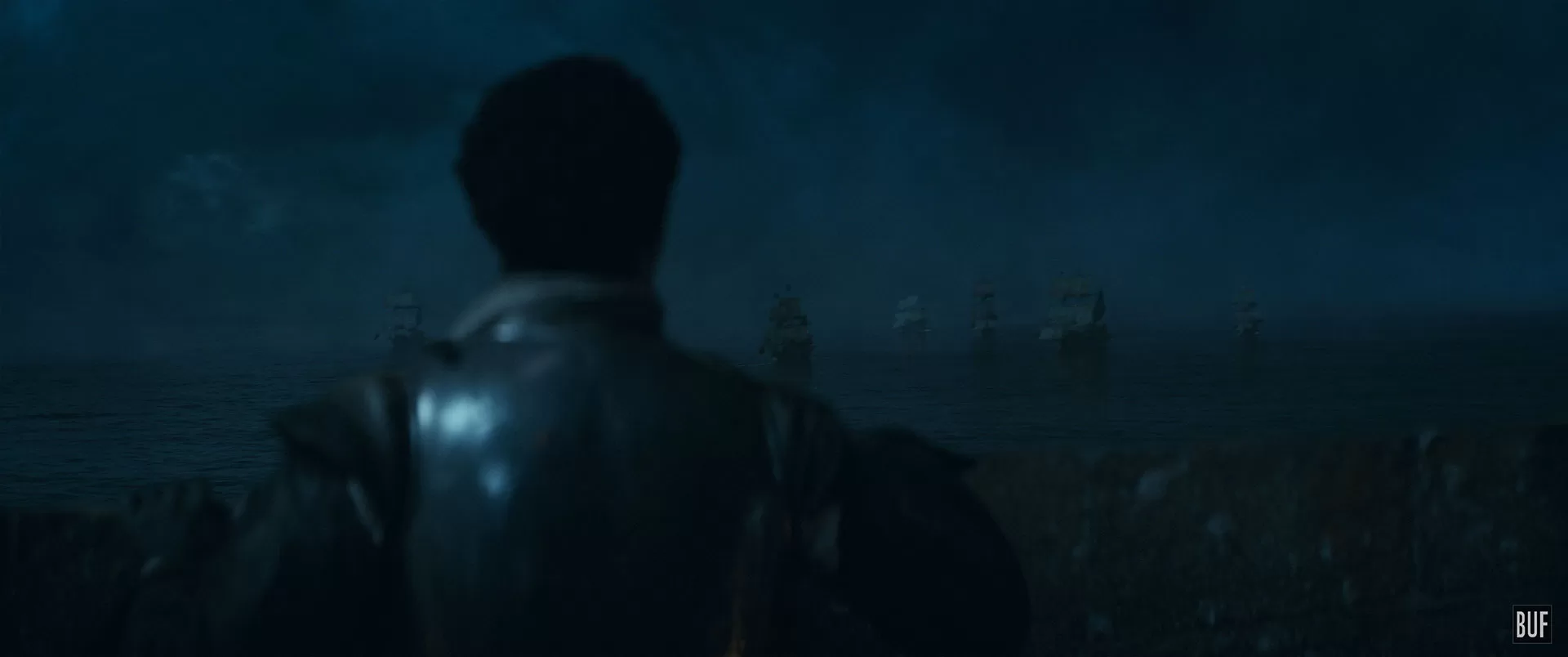
What are the different outdoor filming locations?
There are approximately 80 sets, so I won’t list them all. We mainly filmed in the Île-de-France region and in Paris. At the Louvre, Place des Vosges, in St Germain-en-Laye, at the Château de Fontainebleau, at the Château de Chantilly, at the Château de Pierrefonds, at the Château de Farcheville, at the Abbey of Longpont. Then in Melun, Compiègne, Troyes, St Malo, and Etretat. And others…
How did you approach the creation of the various environments, especially La Rochelle?
Always with the same philosophy, we film in an existing set, to have the playing space, the light, and then we touch up or completely remake the set in VFX. This allows us to have an atmosphere and to maintain a dynamic and realism with the camera and actors. Whether it’s for the streets of Paris, the cliffs of Dover, or La Rochelle.
To recreate La Rochelle, a port and fortified town in the 17th century, Saint Malo intra muros was the perfect location to film. We had all the sets in the same place to shoot our sequences. The town hall, the Fort National, its beaches, and its ramparts provided a base for recreating La Rochelle.
We only kept the ramparts of St Malo, then reconstructed the city of La Rochelle in CG based on topographic maps and paintings from the 17th century. It was important to instantly recognize the city by its architecture, its towers of St Nicolas, of the lantern and of the chain, as they were at that time. For the needs of the screenplay, we added a forest on the edge of the city where the musketeers’ camps are located.
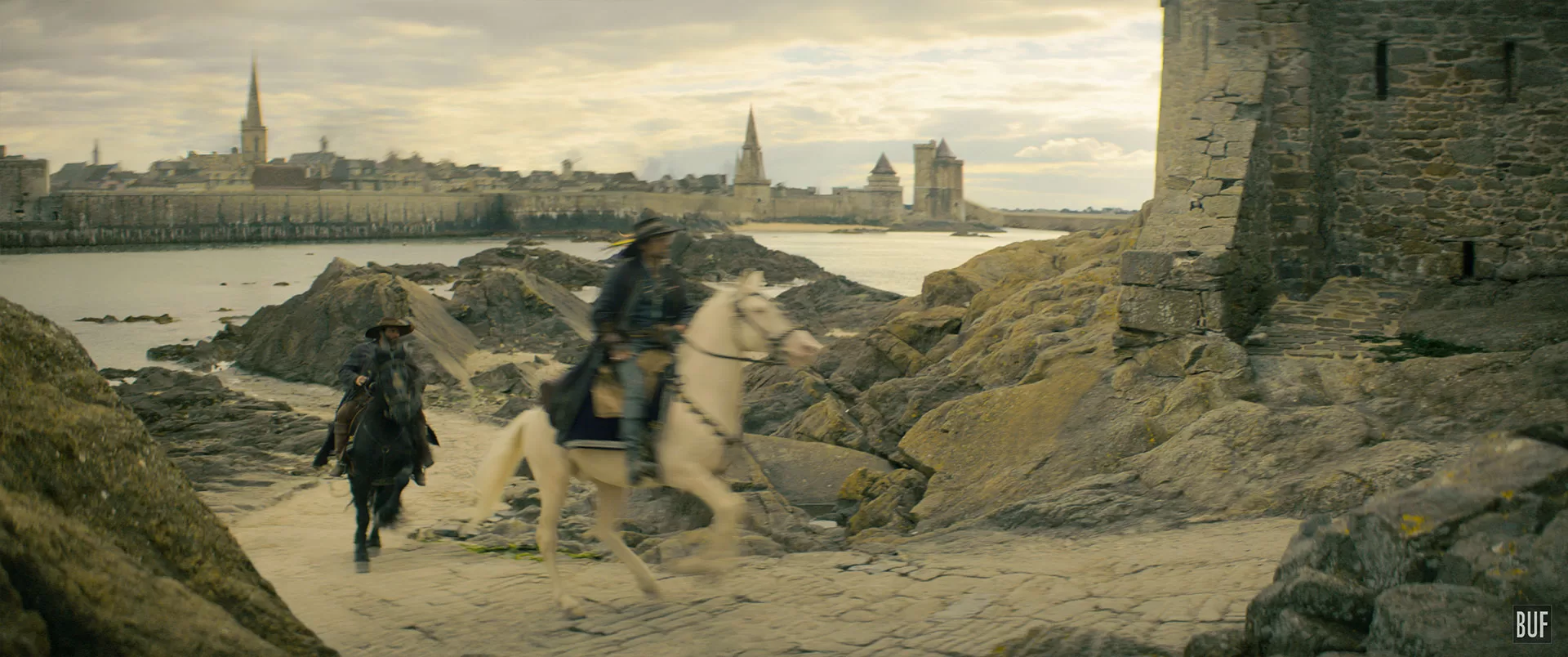
What was the most challenging environment to recreate?
The cliffs for the horse chase scene in ‘d’Artagnan.’ Martin wanted to film this sequence like a car chase, very dynamic, with horses colliding and galloping very close to the edges of the cliffs. We needed a sense of vertigo, danger, and the risk of falling. For obvious safety reasons, it was impossible to film stunt performers near cliffs.
So the idea was to recreate the entire environment in CG. We found a field in Etretat with enough space to film the riders in action and modify the terrain for stunts. We were the second unit and were shooting at the same time as the main unit to match the lighting since they were filming the end of the sequence. We filmed the stunt performers (Marco Luraschi and Laura Cassagne) with a drone for aerial shots and a crane mounted on a buggy for action and ground falls.
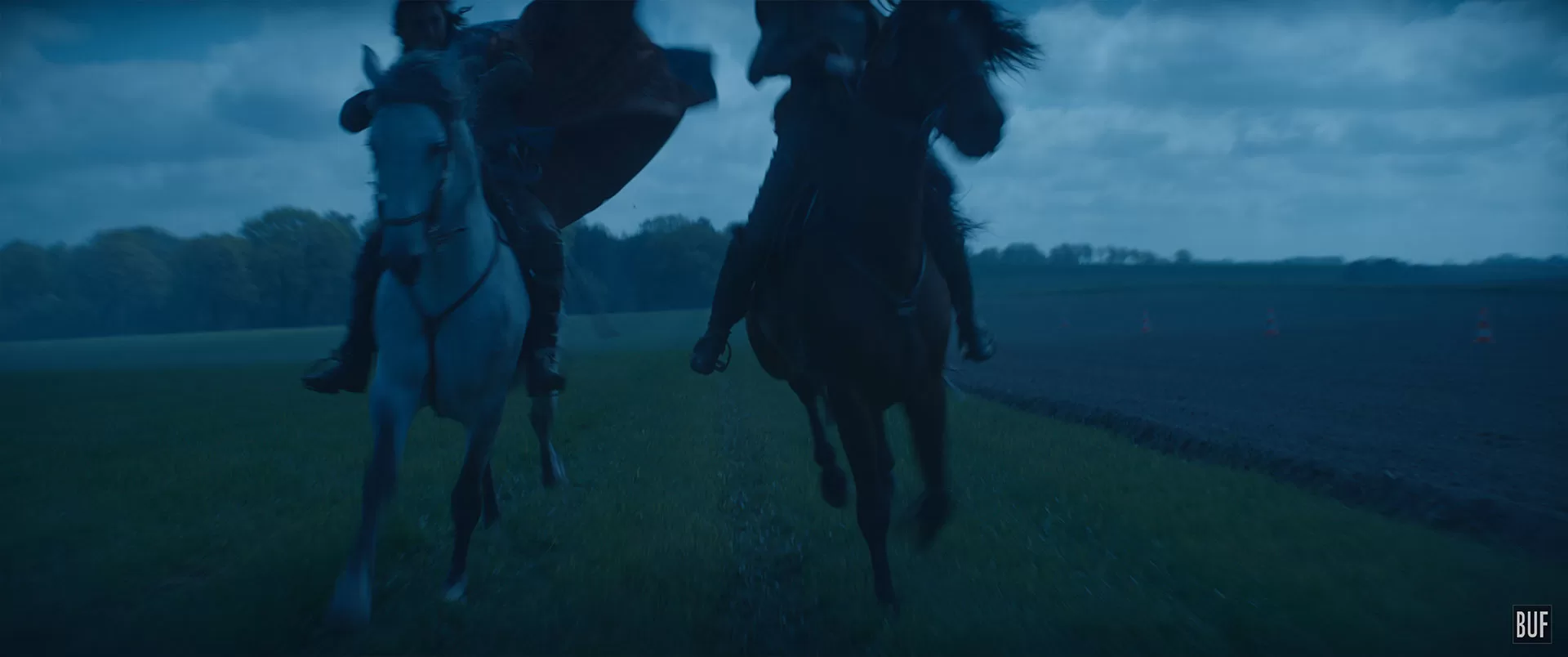
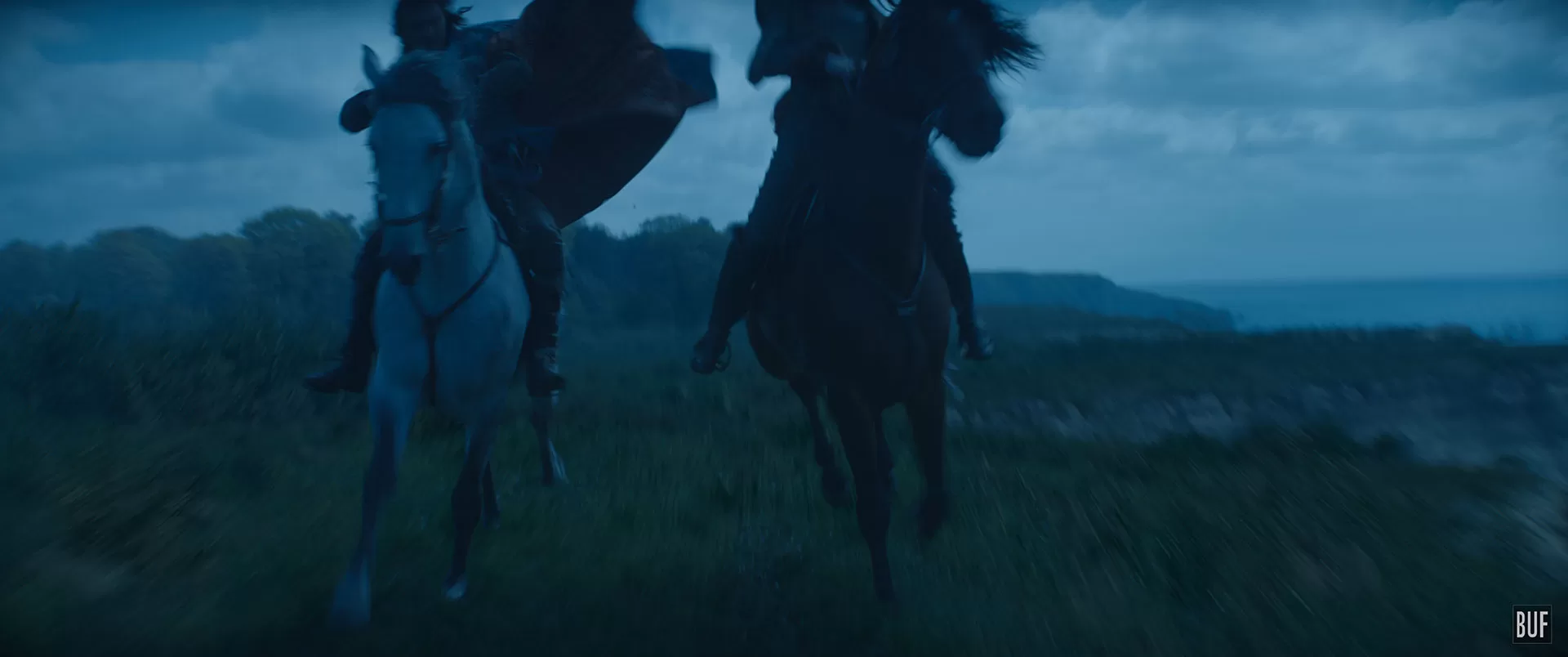
For initial editing purposes, and to do face replacement where needed, I organized a green screen shoot with the director and François Civil and Eva Green. With cinematographer Nicolas Bolduc, we replicated the lighting and camera angle for each shot. I spent a day with a drone team (Full Motion) to film the cliffs in Normandy under the same lighting and tide conditions. We used photogrammetry with these elements and recreated a CG cliff adapted to our scene. We added all the vegetation in CG, from grass to bushes and rocks, to create obstacles and enhance the sense of speed for the camera. There was a significant amount of tracking, masking, and rotoscoping work done by BUF’s graphic artists.
For close-up shots of the actors, we filmed them at the Bry studios, riding mechanical horses that we inserted into the cliff environment. It was a very enjoyable day of shooting. The entire sequence was filmed during daylight, and then Fabien Pascal graded the night scenes at Lux with Nicolas Bolduc.”
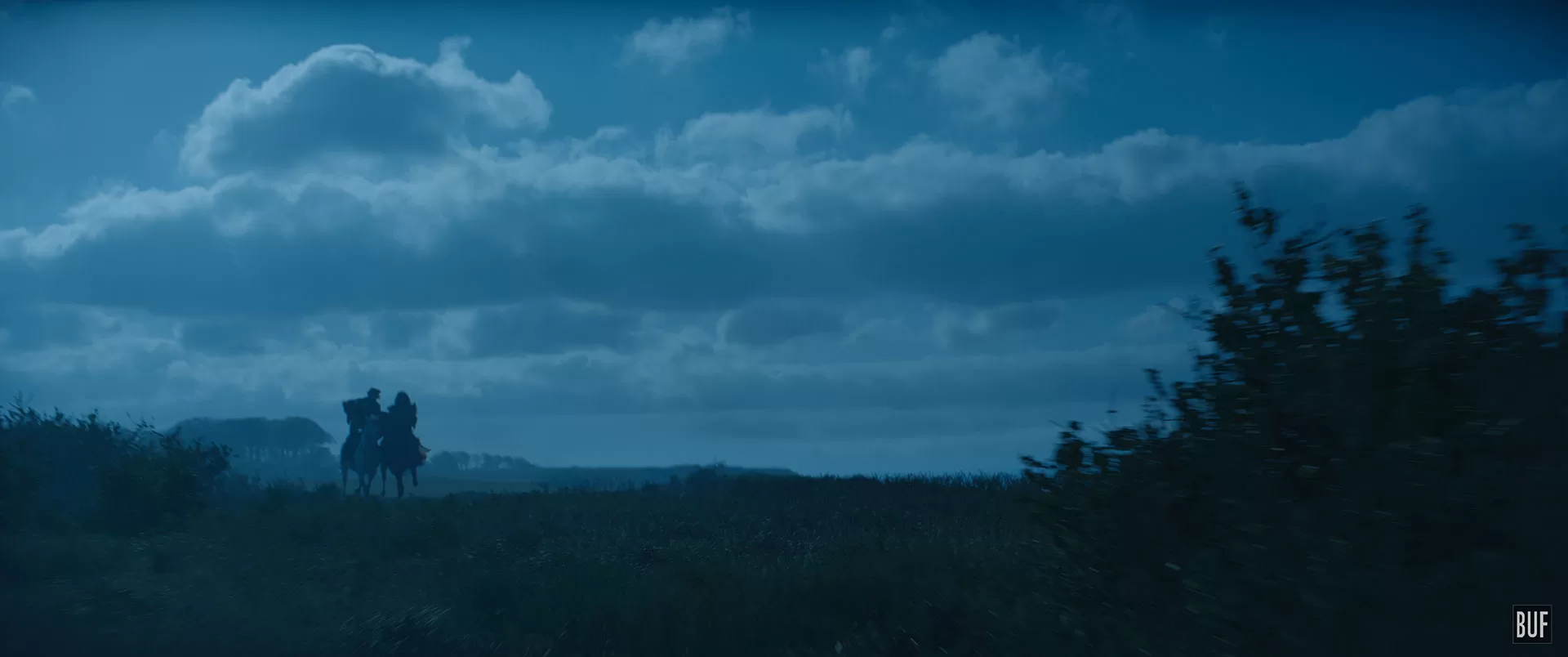
How did you create the English ships and also their destruction?
We started from a 17th-century CG base of ships, which Yann Austin’s team modeled and textured. There are still some replicas of three-masted ships from that period today. So, we had plenty of reference photos and, of course, paintings as well. All the ship plans are fully CG, so we recreated the entire environment with the sailboats. Only the onboard explosion plans are SFX on a green screen. We shot them docked in St Malo.
For the wide shots, the destruction is solid dynamics for debris and mast breaks. The sails and ropes are managed in cloth simulations. Explosions and smoke are simulated with our pyro algorithm. I remind you that at BUF, we only work with proprietary software. We have a team of developers who continuously improve and adjust our software suites to meet project needs.
For “Milady,” we worked extensively on the development of foam dynamics (white water), which we hadn’t done before at this scale.
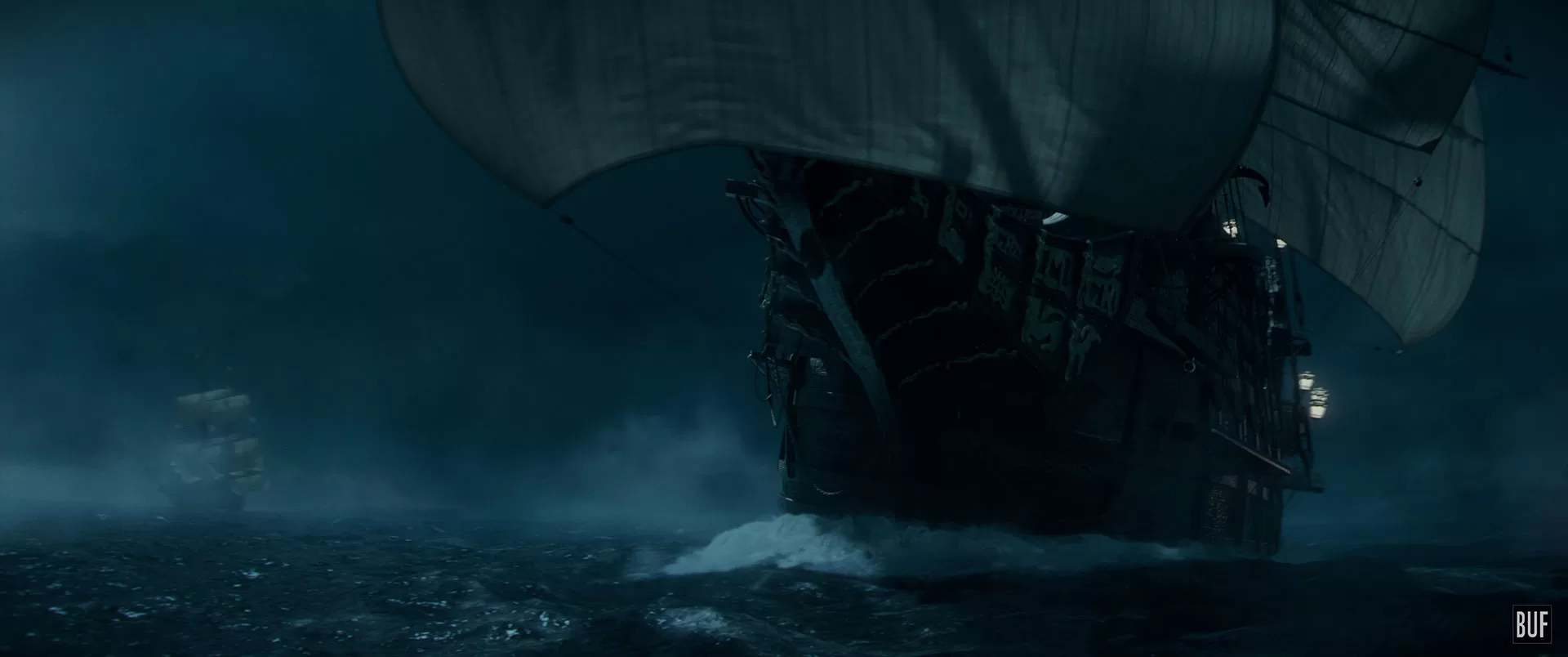
There are many long continuous shots, especially during the battles. Can you tell us about your work on this kind of shot?
In preparation, Martin immediately expressed his desire to stage the fights in long continuous shots. He wanted the viewer to be immersed, plunged into the action, experiencing the tension in real-time. He knows that VFX has a role to play, especially in transitions, weapons, injuries, stunts, and environments. He lets the departments work together and present proposals to him, which he then builds upon. The choreography of the fights is presented by Dominique and Sébastien Fouassier, stunt coordinators. They define the action, whether it’s the actor or the stunt performer facing the camera at a particular moment. Then the director of photography, Nicolas Bolduc, gets involved, setting up the frame, the lighting, the technique, readjusting positions and rhythms. So, between actor-stunt performer changes, stunt setups, horses, the various cameras used, Alexa LF anamorphic, DJI drone, and the length of the shots, there are many transitions to find and make.
My role was to define how to technically make the transition. Sometimes the transition was obvious, dictated by the staging, in a panel, a natural cut, etc. But sometimes we had to make transitions within the action, with the bodies, the set, so you had to find a way to address it. And then there were also changes, improvisation, which meant everyone had to rethink things on the spot. It’s intense, but very exciting to do.
For the swords, the actors and stunt performers would stab their opponents on the side, and the VFX would replace the blade in CG to make it pierce the body. All throwing weapons are in CG. For a shot that was too dangerous in the fight, the dagger blade was entirely in CG. When we shot the long continuous shots, I had a Qtake operator, Esteban Perrin, by my side, with whom I would create VFX mock-ups live on set. This allowed us to quickly readjust the action, the frame, or validate the shot. The shot was built up as we went along, and in the end, we already had the entire sequence mocked up.
For the sequence shot of the musketeers in the St Sulpice forest, there are 11 VFX transitions for a 3-minute shot, which we shot over 3 days. And since we were outdoors, we had to deal with weather uncertainties, sun, clouds, rain… One of the VFX achievements, among others, was adding sunlight to the forest shots that were too dark. I really loved those moments, where you feel like we’re building something together.
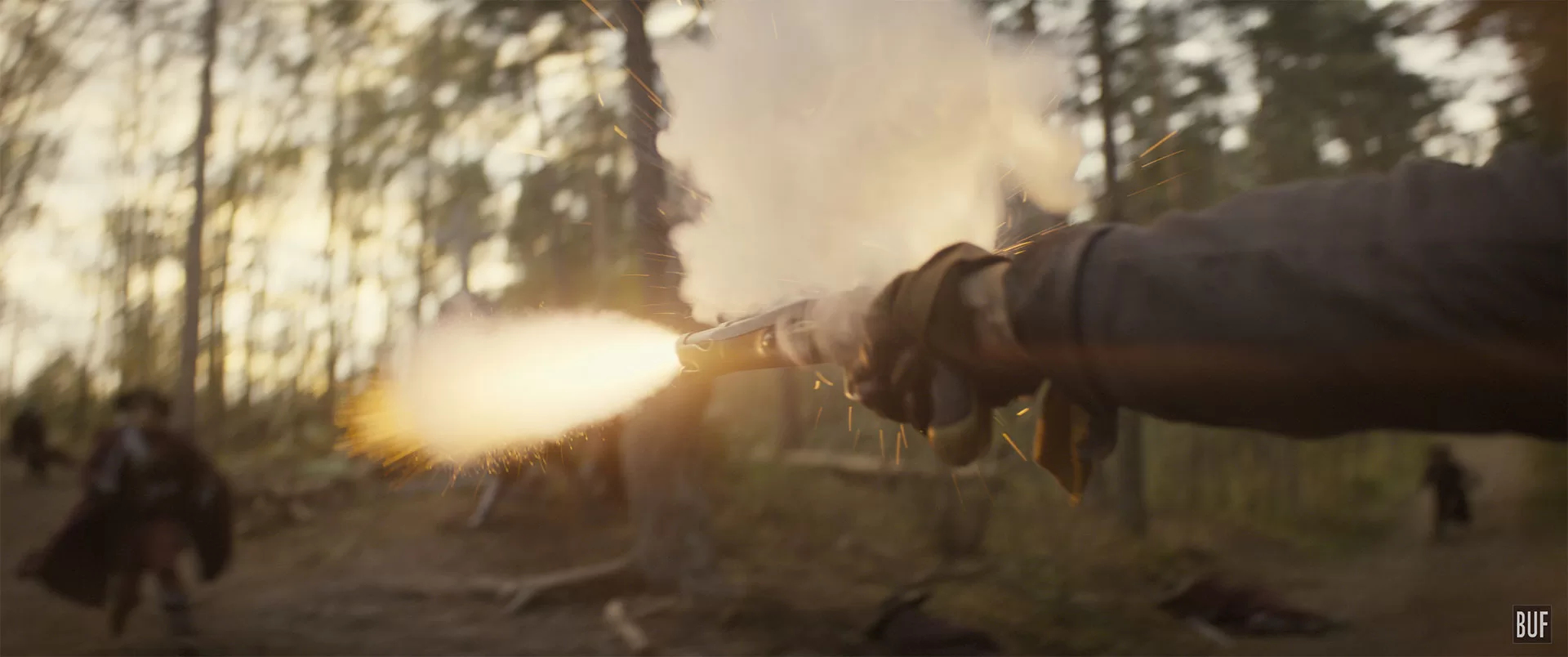
What was the most difficult cut to make during the long continuous shots?
As soon as there is improvisation in this kind of long shot, it complicates everything. It’s not due to a change in the staging, but simply due to lack of time. We were running behind schedule, and the decision had to be made to remove a part of the planned shot to shorten the shooting time. The previous part had just been shot with a horse impacting a soldier and exiting the frame for the continuation of the shot. But with this change, neither the exit from the frame nor the camera movement worked to connect to the next part. We had to redo the entire set in post-production to redo a camera movement. We reused a bad take in which the horse exited at the right place, but the impacted soldier wasn’t positioned correctly. So we had to composite another take of the soldier that I had filmed separately at the end of the day. It was makeshift. All of this for barely 3 seconds of the shot.
How was the collaboration with the SFX teams and the stunt performers?
We were very collaborative. Dom and Sébastien Fouassier, the stunt coordinators, like to challenge the VFX team because they need it to meet Martin’s demands. It was very easy and enjoyable to work with them. There are always surprises, which adds excitement. Mario and Marco Luraschi need no introduction. You can ask them anything, respecting the horses, it’s never a problem.
The same goes for the SFX team (BigbangSFX) led by Jean Christophe Magnaud. The remarkable work on explosions, debris, fire, everything was done very smoothly between us. The team for climate effects led by Olivier Nguyen was always in communication, for smoke and fire throughout the shoot. There’s also Stéphane Linet, the armorer, with whom I worked closely. Depending on the shots and safety, the gunshots were either done live or in VFX.
The production provided me with two days of SFX element shooting in the studio, to cover all the needs following the shooting of both installments. Gunshots from pistols and rifles and flames for the barn fire. Plus numerous elements for the film. There were many and significant collaborations with these departments, with a really pleasing result.
What was the most challenging stunt to enhance?
That would be d’Artagnan’s leap from the ramparts at the beginning of the Milady sequence. It’s a continuous shot where the camera follows d’Artagnan and Milady escaping their pursuers by jumping from the ramparts. The camera tracks d’Artagnan all the way into the moat.
Of course, there are several VFX transitions from François Civil to the stunt double. But also, between the moment Marco Luraschi (the double) clears the battlements and the point where he falls. We didn’t have permission to set foot in the moat, which wasn’t deep enough anyway. So, we shot Marco suspended from a crane, with Sébastien Fouassier operating the camera just above him. They were held by cables and dropped above a pool until Marco hit the water. Another constraint was that the camera must not touch the water at all… So, I stitched all of that together in post-production and recreated the entire moat and water in CG during the fall, as well as the passage through the water.
As an anecdote, the parts of the sequence with François were shot nearly a month after the stunts. So, there were different lighting and atmospheres to match.
The final battle takes place amidst a raging fire. How did you create this fire?
It was quite a challenge taken up by all the teams. It’s a 4-minute long continuous shot filmed over 2 days at the Bry studio, set up with wood and plaster.
The idea was to have a real fire base for the lighting and atmosphere. Stéphane Taillasson, the production designer, conceived the set taking into account the desires and needs of the stunt performers. He also worked closely with the SFX team so they could install their pyrotechnic network and controls during construction.
JC Magnaud (SFX) established a safety perimeter around the actors and camera crew. Any fire close to them would be CGI. The emergency exits planned by the set decoration would be set ablaze using CGI. Flying embers, heat effects, and falling flaming debris would all be CGI. We installed LED ribbons for lighting in the areas of the set where we would add fire. It helps with integration and serves as trackers.
We made 11 cuts for this shot. The fire is lit locally and only in front of the camera. As soon as the camera pans too much, a cut is necessary. The segments couldn’t be too long because it was taxing for the actors and crew. It’s worth noting that due to the carbon monoxide the fire emits, roughly speaking, you shoot for a minute, then you’re out for 10 minutes. To be able to add the fire in CGI, I filmed flame elements. We didn’t have the budget for CG fire, and I like using photographic elements. The fire composed in CGI matches exactly the fire from the shoot.
With the storyboard of the continuous shot, I analyzed the axes and requirements. The next day, I did a lidar scan of the set, and we filmed flame and fire elements alongside the SFX team. Fire-engulfed posts, barrels, the ground floor when we’re upstairs, etc… Then, I filmed fire elements against a black background to complement wherever necessary.
It’s the Mac Guff team, supervised by Dan Rapaport, who rigged all the CGI for this sequence, both interior and exterior of the set. They did a splendid job. We built this sequence step by step; it was a lengthy process. There was a lot of tracking and masking work. They created several CG set extensions with fire and smoke, integrated all the fire elements throughout the 4-minute shot, added heat effects, the CG dagger, and most importantly, handled the 11 transitions, some of which were quite tricky. There are many moments on the upper floor where we transition from actors to stunt performers and back to actors. The plan’s dynamics work very well. The end of the shot with Milady and the debris falling in flames was a beautiful challenge. All the elements filmed in spherical are reworked and composed by Mac Guff to create the illusion of the drama. The entire set is rigged and extended in CG to add the fire behind all the actors.
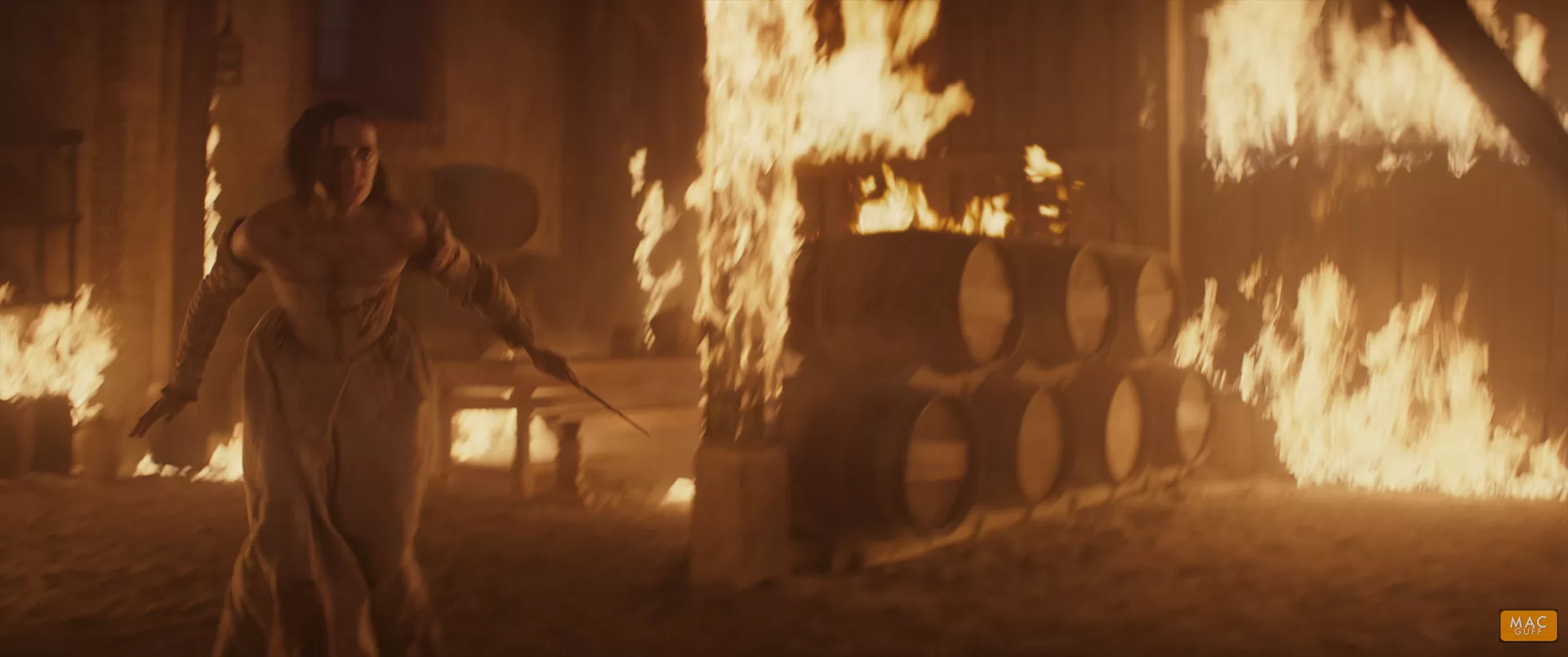
Can you reveal some invisible effects to us?
I hope that there is plenty that is not seen, that the viewer remains immersed in the story.
What was the main challenge on this film?
The wide variety of VFX to be produced and to maintain the homogeneity and quality of the effects.
Is there something that has given you sleepless nights?
The boat sequence.
What is your best memory about this production?
Difficult question. There are a lot of great memories from filming and post-production. I admit that I really enjoyed the team screenings, because it was the first time that I really experienced the film as a spectator, and alongside the artists who discovered their work at the heart of the film.
How long did you work on this film?
From preparation, through the 8 months of filming and the 9 months of post-production. It’s been roughly 2 years.
The 9 months cover the production of the VFX of d’Artagnan and Milady. Fortunately there was the Christmas break between the two post-productions 😉
What is the VFX shots number?
806 VFX shots.
What is your next project?
I have just finished filming and started post-production on Monte Cristo, adapted and directed by Matthieu Delaporte and Alexandre de La Patellière, produced by Chapter2 and Pathé. In between, I shot a medium-length film with Leos Carax, the post production is to come.
A big thanks for your time.
WANT TO KNOW MORE?
BUF: Dedicated page about The Three Musketeers: Milady on BUF website.
IIW Studio: Dedicated page about The Three Musketeers: Milady on IIW Studio website.
Mac Guff: Dedicated page about The Three Musketeers: Milady on Mac Guff website.
BUF: Dedicated page about The Three Musketeers: D’Artagnan on BUF website.
IIW Studio: Dedicated page about The Three Musketeers: D’Artagnan on IIW Studio website.
© Vincent Frei – The Art of VFX – 2024
Dive into the captivating world of Apple TV+‘s The Changeling, where Pixomondo‘s visual effects redefine imagination:
© Vincent Frei – The Art of VFX – 2024
Immerse yourself in the fight for India’s freedom with Ae Watan Mere Watan. Step back in time to 1942 and witness the struggle unfold with invisible visual effects crafted by Indian studio FutureWorks:
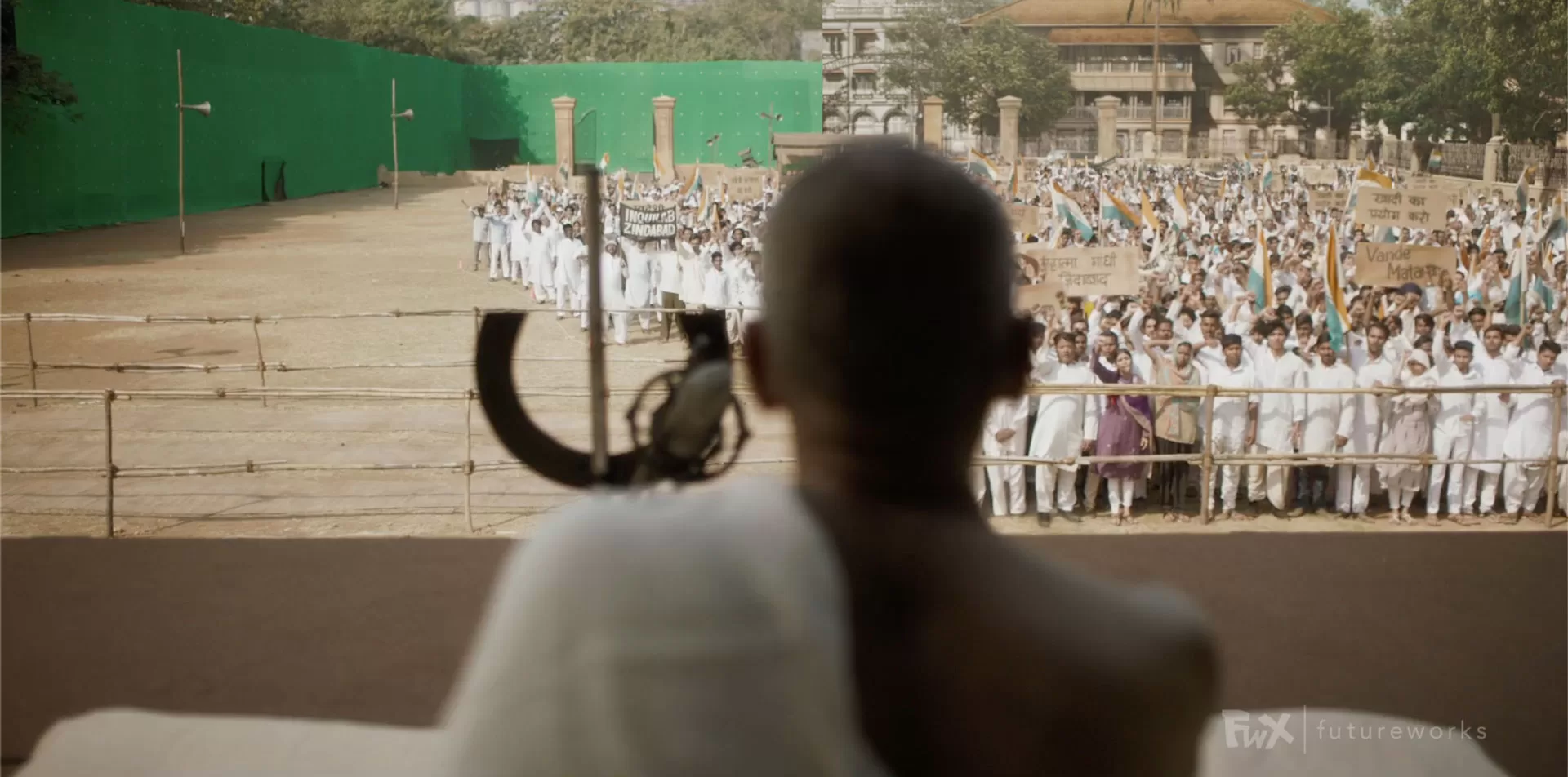
© Vincent Frei – The Art of VFX – 2024